#mfb character analysis
Explore tagged Tumblr posts
Text
How to Read MFB Like a Professor: Chapter 1
Every Trip is a Quest (Except When It's Not), ft. The Silver Pegasus
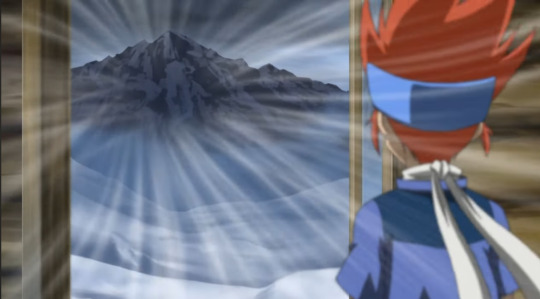
Key Concept: When a character goes on a trip, pay attention to what they learn about themselves.
What's this? Read the series intro post.
A seemingly innocuous trip in media can, if analyzed through this lens, reveal insight about a character's growth and motivations. In order to see how, you have to understand that every quest has 5 defined components:
The person going on the quest (obviously)
What they hope to achieve (May or may not be a tangible object. Think of it as their "Holy Grail" so to speak)
Their stated reason for going on the quest.
Obstacles that make the quest difficult (terrain, other characters, personal flaws, etc)
The most important part: The real reason for going on the quest. This must be different from the stated reason, and is the thing that grants your desired insight on the character.
In the episode The Silver Pegasus, Gingka returns to Koma Village after losing a battle with Ryuga at the Dark Nebula Headquarters. Hokuto then tells him of a shrine in the village which may have an upgrade for Pegasus and might thus help him gain the power needed to defeat Ryuga. Gingka goes on a fairly obvious quest in this episode, but for the purposes of recap and the analysis, let's break it down into its components.
The Quester: Gingka himself
The Holy Grail: A sacred text, which may upgrade Pegasus's strength
Stated Reason: Get more power to defeat Ryuga
Obstacles: Snow, ice, avalanches, and Gingka's shattered self confidence
The real reason: I'll get to this in a second
As 1-3 are pretty straightforward, I'll start by discussing the obstacles on Gingka's quest. These obstacles can be internal or external, but as you will see as we go along, dividing them is pretty arbitrary.
The harsh terrain poses a challenge physically but isn't the primary thing that is hindering Gingka in his journey to get to the mountain shrine; the wind and snow are merely representatives of the internal struggle taking place. His preoccupation with defeating Ryuga gives him motivation to keep going in the beginning of his quest. Note that this is his stated reason for going, and this makes sense. The reason he is consciously aware of is what provides him with the fuel to persist through these initial challenges.


Of the first of these dangerous obstacles in his quest are icicles which fall from above. These don't seem to faze him at all, though. With a cry of rage, he unleashes Pegasus and shatters them all mid air.
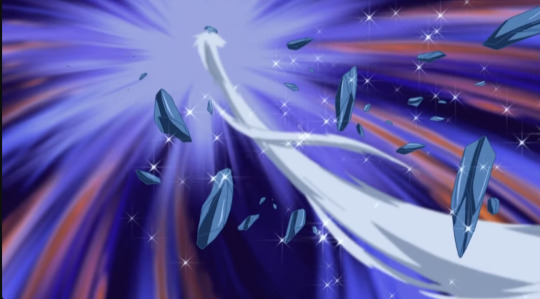
However, when the ice is gone and the danger is passed, Gingka realizes he is still screaming. His face softens into a look of deep sadness. To me, this foreshadows how using his pain to drive him forward is only going to hurt him in the end, leaving him hollow. The prolonged screaming shows that if this is how he chooses to drive himself forward, he will only continue to struggle and feel pain even after he has no reason to.
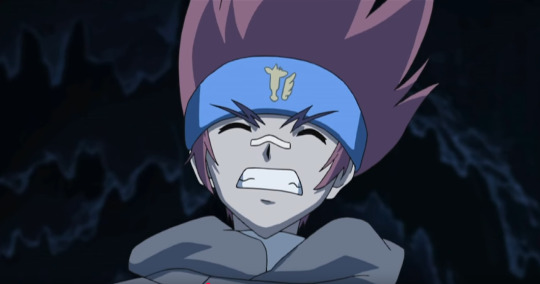
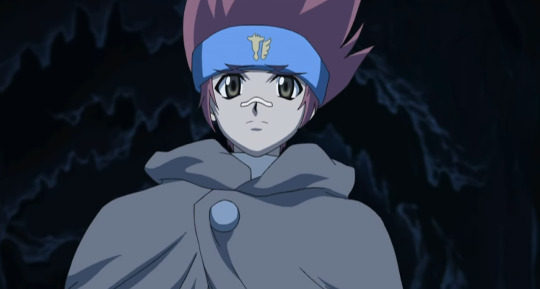
Driving this point home is the next shot: Gingka proceeds into a dark cave, seeming very small against the backdrop and very notably alone. If you listen carefully, you can even hear the echo of his footsteps before the scene cuts away

Though this scene is short and the obstacle is, at the end of the day, pretty trivial (he had no issues getting past it after all), it's the first sign of the emotional backdrop of this quest and the feelings weighing heavily on Gingka at this point in time. Remember that during the battle with Ryuga, we see Gingka in a rage unlike any we've seen before, and any we see again in the future

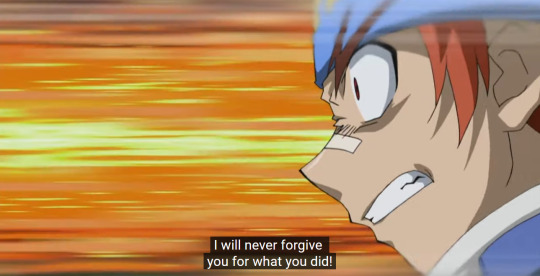
As we see in this part of The Silver Pegasus, though, this rage isn't good for him. In L-Drago Awakens it directly leads to his defeat, and similarly, The Silver Pegasus shows that it only leads to isolation and continuation of his grief.
Not only that, after losing and telling Kenta about the death of his father, Gingka disappeared to Koma Village without any notice. He abandons his friends and can't bear to share the burden he is carrying. It's only emphasized further by his small frame against the gaping, empty mouth of the cave.
Still, though, Gingka moves forward. His journey isn't complete yet.
The next obstacle he faces is a wall of ice in his way. He deals with it similarly (launching Pegasus at it, as one does in Beyblade), but notably, on his first attempt he isn't able to break it. Gingka is visibly irritated, and when he tries again, he tells Pegasus to "crush it to pieces".


Again I feel this drives home the rage currently fueling him, and while this allows him to brute force his way through this tougher obstacle, it doesn't come without consequences. Immediately following this, an avalanche threatens to crush him.
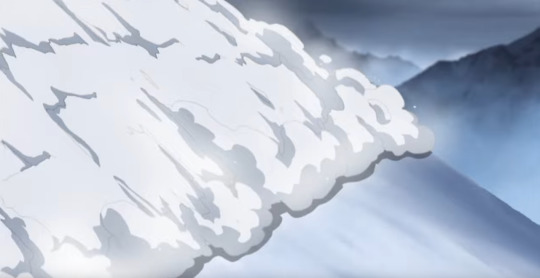
It's not explicitly stated that the avalanche is caused by the force used against the ice block, but given that it occurs without a break to show what his friends are up to in Koma Village (as all the other obstacles in this episode do), I think it's fair to read it that way.
The show does tell us that the avalanche represents Gingka's feelings about Ryuga, though. You could say the floodgates have opened, and Gingka is forced to confront what is driving him forward.

He remains steadfast in his stated goal, though; above all, he is concerned about beating Ryuga. Nothing else is on his mind.
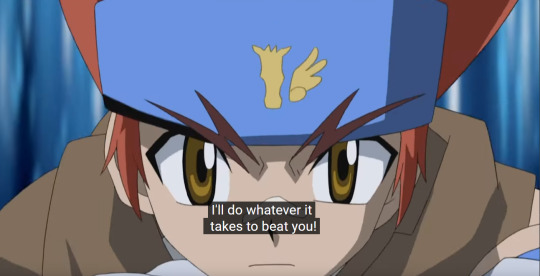
When he clears the avalanche, though, it is quiet once more, and Gingka is once again painfully reminded that he failed to beat Ryuga when it mattered. He even questions whether the upgrade to Pegasus is waiting for him at the end at all, demonstrating the doubt that plagues him the further along he goes.

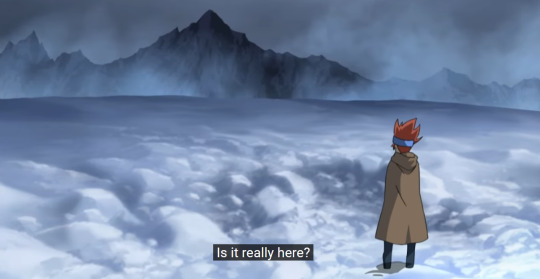
The final obstacle in Gingka's path is a snowstorm, weather that reduces his visibility down to zero. Gingka's confidence now has deteriorated fully, and he is at the hardest part of his journey to the top. This is represented by the low visibility in the storm: Gingka has quite literally lost sight of himself and the path before him. In the snow, he imagines Ryuga laughing at him and insulting his father, and though this fills him with just as much rage as before. He raises his launcher in bitter retaliation, but his spirit is broken: he is unable to launch Pegasus, and it falls uselessly from the launcher just as it did when he attempted to battle Osamu a few days prior.
Gingka sinks into the snow, defeated, his confidence in himself truly shattered. Ryuga's laugh still rings out in his ears and he apologizes once more to his father, but this isn't enough to get him back on his feet. His rage and grief were never enough to sustain him, and he is forced to reckon with that fact now, at the final obstacle of his quest.
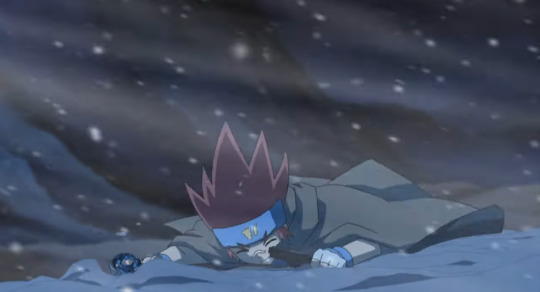

Importantly, Gingka is only able to get back up and continue onward once his motivations shift away from grief and revenge.
Only the thought of his friends gets him to reopen his eyes and face Pegasus again after his failure. This is his reminder that he isn't fighting alone, and is the first step in understanding what the real purpose of Gingka's quest is.
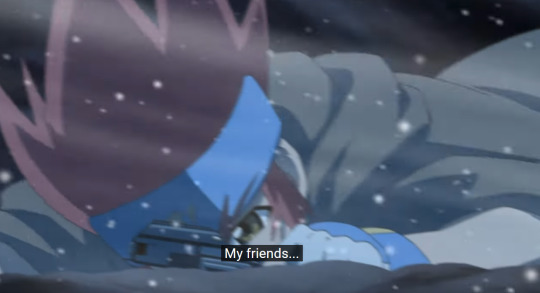
Pegasus glows in response to Gingka's words, as if in agreement.
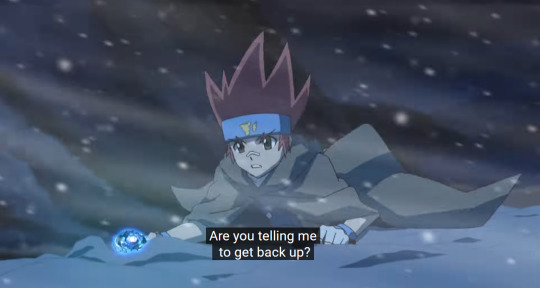
This is where he realizes that his friends are behind him, and that Pegasus is beside him. He was never in this journey alone, despite what he may have believed. He pleads with Pegasus for its strength, and sharing the burden with his partner, his bey, is what allows him to get up and continue on.
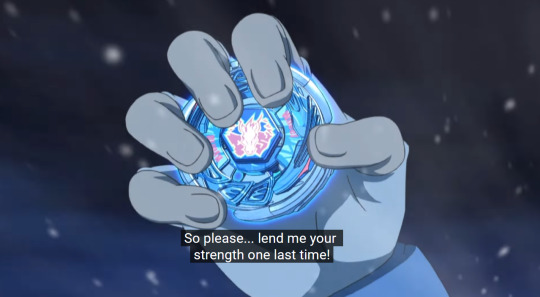
Here we see the path to his goal open before him amidst the snow, symbolizing the beginning of his understanding. Of course, change isn't instantaneous; the persistent snowstorm represents the continued struggle against the emotions that have been holding him back up to this point. Now, though, Gingka has found it within himself to move forward, and he is willing and able to take that path.

Now, all that is left for Gingka to do is retrieve the upgrade to Pegasus, and go challenge Ryuga again. Right?
Except there is no upgrade. There is no sacred text. There is no easy way out for Gingka.

I almost forgot to mention. More often than not in a quest, the character will fail to achieve their stated goal. Whether they fail on the path or, in this case, the Holy Grail simply doesn't exist, there will usually be something that causes the initial reasons for the quest to be a failure.
This doesn't mean the quest is a failure, though. In fact, the inability to achieve the desired goal is what causes the self reflection necessary to move forward. The character's action when confronted with this failure is what reveals the true reason for the quest at all.
The Silver Pegasus actually tells us this point explicitly:

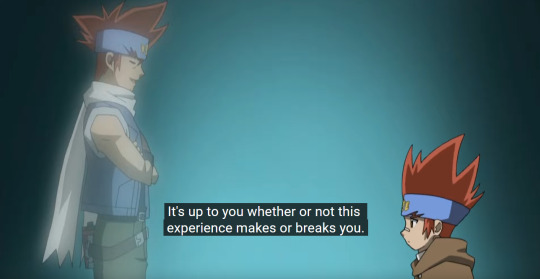
In fact, the true reasons for Gingka's quest are told to the audience as well: Reaching the shrine shows that he was never as weak as he believed himself to be, and that so long as he believes in himself and his bey, he can persevere through any challenges. He is then able to see his loss to Ryuga for what it is-- a setback, not an abject failure or a reflection of his ability.

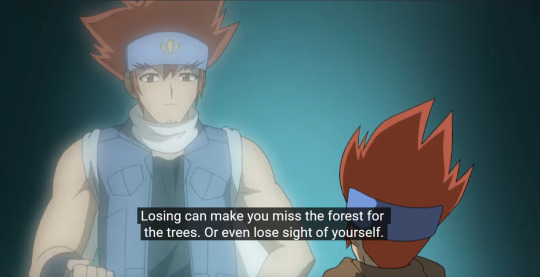

Gingka exits the shrine to light shining on his face and the snowstorm gone. This is symbolic of his restored confidence and the hope he now has going forward. He smiles, and declares his belief in himself.

At the bottom of the shrine, his friends are waiting for him. They could not follow him on his quest, but this is confirmation to him that when he needs them, they will always support him. They have been there for him all along, even when he fled from the promise of their comfort.

Again they are all bathed in light and Gingka holds Pegasus up to the sun, another declaration of hope, confidence, and belief in himself and the people (and bey!) who support him.
Gingka concludes the quest then, having restored his spirit and grown as a person. From the beginning, the show hammers in again and again that one's spirit is what determines the outcome of a battle. This episode is Gingka's first recovery from a major setback, and the quest he goes on foreshadows how he will overcome similar setbacks later in the series. It puts into play this core principle of the show in a way that is easily digestible, and one that will resonate with the audience even if they don't consciously realize when it comes up again later on. In essence, Gingka's quest here encapsulates his future character arcs and is even mirrored by others' in the series (such as Kyoya a few episodes prior, when he realizes Leone was by his side all along; he fails to defeat Gingka that episode, but is able to let go of the bitter resentment he held toward Gingka as well as the relentless need to solve everything alone-- but that's an essay for another time). You could go as far to say that it spoils the rest of the show.
For how cut-and-dry this episode is, it provides a lot of insight into Gingka as a character, both now and in future arcs. Quite frankly I wasn't expecting to glean that much from this; I thought the concept of the quest was shallow until I tried applying it for myself; only after I started writing did I realize just how much was going on underneath the hood.
It was a lot of fun! I look forward to doing more of these as I keep reading the book. The next chapter is about communion, so I'll have to review which episodes have characters eating together.
Thank you for reading!!
#HTRMFBLAP#from rain#beyblade#beyblade metal fight#beyblade metal saga#beyblade metal fusion#mfb#ryo hagane#gingka hagane#character analysis#analysis#THIS IS FOUR FULL PAGES IN GOOGLE DOCS#2K words.... oh my god i have terminal yappingitis#but like this is so fun#i am having a grand time
36 notes
·
View notes
Text
The moment Kyouya is shown as not any blader:


#kyouya: magic and supernatural don't exist#also kyouya: *sees auras*#beyblade metal fusion#ginga and kyouya#kyouya character analysis#kyouya tategami#mfb episode 1#mfb 1x01#kyogin
45 notes
·
View notes
Text
Beyblade character design analysis: Kenta Yumiya
Masterpost here. Now let's take a look at Kenta, who somehow went from getting beaten up by the Face Hunters to gaining Ryuga's respect

Starting with the hair, it's green. This has nothing to do with his bey, but the green, and more specifically this shade, make Kenta stand out. The rest of Kenta's design is fairly generic, to the point where some actual background characters have more captivating designs (like Django), so the hair helps set him apart from someone like Osamu. Green is one of the lesser-used hair colors in mfb, and the characters with green hair all have a very dark shade (like Kyoya). Kenta is the exception, which catches our attention when the rest of his design doesn't
Kenta wears a yellow shirt with a blue stripe. The yellow-green-blue color scheme looks like the Brazilian flag (insert joke about the time the Garcias jumped Yu). The design itself is quite plain, but the colors are bright enough to make Kenta not seem like a background character. He's still a generic audience surrogate in design (and character, at least at the start), but without being too generic as to be mistaken for a background character
He lacks gloves or a visible belt, which are accessories used by most bladers. This makes his design seem more generic, and it's on purpose because almost everyone else has at least one of these 2. However, Kenta does have a belt that holds his launcher, which is just not seen very much. He is a strong blader, but doesn't seem like it at first
Kenta wears shorts. There's nothing I can really say about them other than they contribute to his child look (I mean, he is a child, but he looks way younger than almost everyone else)
His shoes are unremarkable, but unlike some other footwear, seems like something a real-life kid would wear, cementing Kenta's role as an audience surrogate for the first few episodes (though he grows out of it fairly quickly)
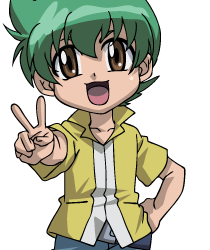
His hair in Fury is mostly the same, but altered slightly to be a little more detailed. This is still the same Kenta from the previous seasons, but he's older and more mature. He also becomes a lot more important to the plot in Fury. Despite having less screentime than in Fusion, his contributions are a lot bigger
His shirt gets a redesign. The new style makes him look older, which is the primary purpose. The blue stripe is also gone and instead we have a white, vertical stripe. With his redesign being more detailed in general, the blue stripe loses its purpose of making Kenta stand out as an important character. The white gives it just as much detail, if not more, but isn't as flashy. Plus, Flash Sagittario's facebolt has white in the center, unlike Flame's. Subtle foreshadowing maybe?
Kenta wears pants that are rolled up to look kinda like shorts. It makes him look older while retaining most elements from his original design. Despite how much Kenta grew over the course of the series, at his core he's still the same
His shoes are a little more detailed but still essentially the same. Not much I can say about them
16 notes
·
View notes
Text
The Devil(s) of Metal Fight Beyblde.
Dr. Ziggurat, the main antagonist of Beyblade Metal Masters, shares many parallels and similarities with the Christian Devil.
He is a ruthless and manipulative executive of an enterprise called Hades Inc., who enjoys making "deals" with other people. Note that Hades and Hell were interchangeably used in Greek mythology to describe the afterlife. The deals he makes are almost like demonic contracts: Zeo had to become a lab rat to save Toby, losing his sanity in the process. Ziggurat takes advantage of desperate people like Zeo and even Julian.
Ziggurat transformed Toby into Faust, whose name comes from the main character of a German legend. Faust, inspired by Johann Georg Faust, made a contract with the devil: Mephistopheles would serve him, and after a certain number of years, the devil would take his soul. Faust sacrificed his soul either to gain knowledge or for material and personal gain, depending on the version. Toby accepted the arrangement against his will, and even if he was cured, he lost himself in the process. He can play Beyblade again, but as Faust, he is only a soulless tool.
The doctor himself seems to have "sold his soul," since he doesn't care about ethics or the fact that he is using children for his experiments. Hikaru explicitly said that some of the bladers incompatible with the arrangement system were so impacted by it that they had to end their careers.
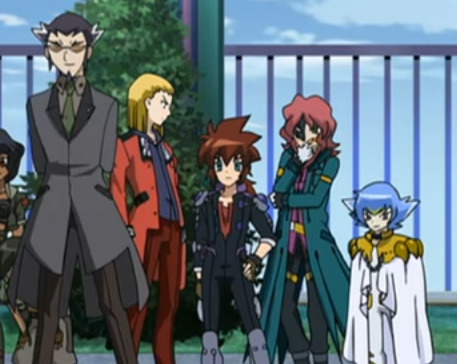
Physically, Ziggurat appears taller than most of the cast, though this is because they are all children. He has spikes of hair at the back of his head, like Damian, that emulate horns. He also wears a dark gray suit, which contrasts sharply with all the colorful characters (even his collaborators, Daidoji and Pluto, seem more colorful than him). He is as gray and dark as the hellish world Damian creates with his Kerbecs.
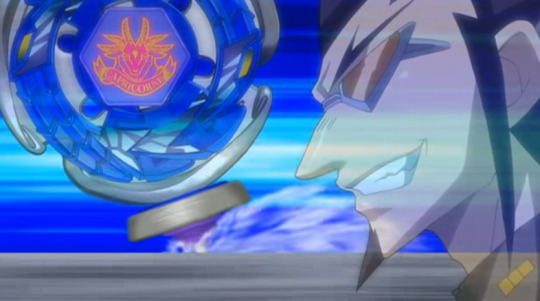
His name comes from ancient structures called ziggurats, built by the Mesopotamians for cult practices. Daidoji's name means (literally) "great road/way to the temple". They were both part of the Hades cult, lead by Pluto who lived in a temple. However, Ziggurat can also be a reference to the German word "Ziege," which means goat. Ziggurat's design also emulates the animal, with his goatee and spiky hair. His Beyblade is Spiral Capricorn, and in the anime, its Bey beast is often depicted as a simple goat.
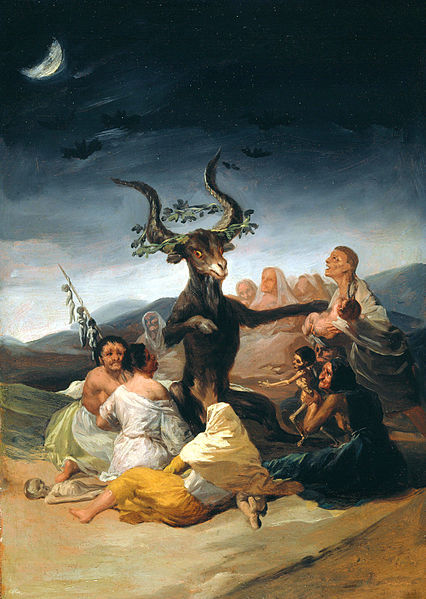
This animal is often tied to the Devil and is one of the forms it takes. The painter Goya depicted a gathering of witches with "Witches' Sabbath" (Goya, 1798), where the Devil takes the form of a goat and is offered children to eat. While the doctor doesn't (seem to) eat children, he effectively despises them and shows a lot of disdain towards them. He also steals their innocence in a way. Zeo and Toby do not take back their Aries Bey; they now use Beys with the Spiral fusion wheel, reminiscent of Spiral Capricorn. Aries is a sheep and is typically associated with innocence. They cannot go back to who they were; they are permanently scarred by what they have been through during their time in Haves Inc.

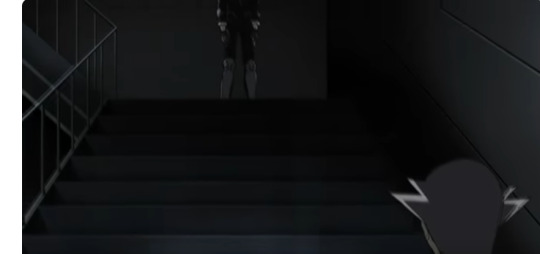
In the scene where Zeo is stopping Ziggurat, he is at the bottom of the stairs, symbolizing a shift in power dynamics between them. This positioning could also symbolize Zeo casting Ziggurat back to Hell, as Hell is below the Earth in popular culture.
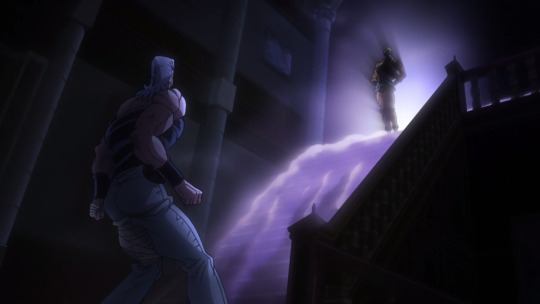

"JoJo's Bizarre Adventure" has previously utilized its antagonists, DIO (assimilated to God) and Diavolo (a mafia boss, assimilated to the devil), in a similar manner. DIO is upstairs (heaven), while Diavolo is at the bottom of the stairs (hell). I would add that in the Metal Saga, it is common for villains to fall: Nemesis and Daidoji fell into a pit, and Hades City fell into the abyss of the sea.
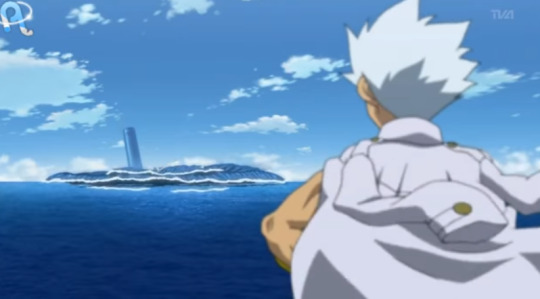

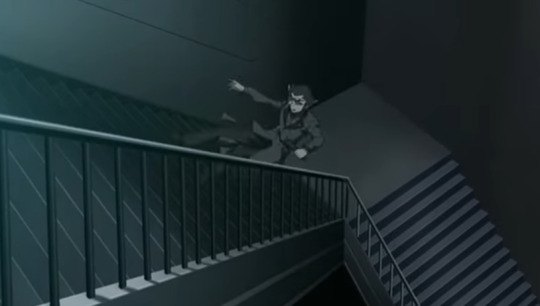
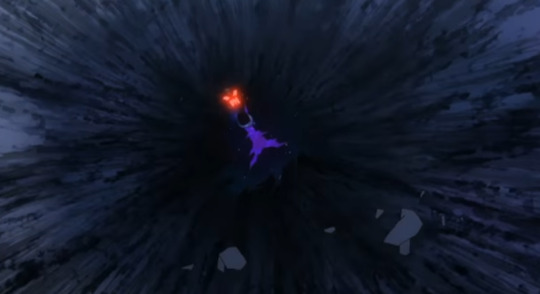
These falls can be interpreted as both a physical defeat and a symbolic triumph over an evil that is cast back into hell.
Ziggurat is a more traditional version of the devil who makes deals with people and manipulates them, while Nemesis embodies the devil of the apocalypse, wishing for total chaos.
#mfb#metal fight beyblade#metal fury#zeo abyss#character analysis#julian konzern#toby beyblade#daidoji#doji beyblade#pluto beyblade#nemesis beyblade#jojo no kimyou na bouken#jjba diavolo#dio jjba#damian hart#dr ziggurat#ziggurat beyblade
34 notes
·
View notes
Note
Here's another question I have: there's been a debate with some friends of mine over how Ryuga was handled in Fury specifically that he regressed despite his character development in Masters. What do you think?
I don't think he regressed at all. For him to have regressed, he would have to return to his characterization in Metal Fusion, which is a far cry from Metal Fury.
Ryuuga, at the start of Metal Fury, is just chilling on a random island and indulging in his habit of training in a volcano, just like we see him before in the flashback between Fusion and Masters. So, no difference there. In Masters, he's mellowed down considerably from the person he was in Fusion and his demeanor is no different in Fury.
When Gingka and co. show up, he wants nothing to do with them and that's not really out of character since the only time Ryuuga ever goes near them is during a world ending crisis. He shows up because he needs to "repay a debt" to both Gingka and Tsubasa and then just wanders around until Ziggurat tries to recruit him.
It's only when he learns of the Star Fragment that he shows any interest in what they have to say, and that's only so that he can take their power for himself. Ryuuga has always wanted to be the strongest. That is what attracted him to the Dark Power in Metal Fusion, and Masters changes nothing about that even if it seems like it does. It's just that most of the time, Ryuuga is so overwhelmingly powerful that there's not much to desire there. By learning of the Star Fragment, Ryuuga learns that there is still a power out there that he hasn't mastered and Ryuuga has always coveted power. And we see that he is at least interested in fighting strong opponents, which is the whole reason he follows Jack to Hades Inc. in Metal Masters.
On the topic of allowing Kenta to follow him around, it likely came from the expectation that Kenta is a weakling who would quit soon enough, but he manages to hang in their. This piques Ryuuga's interest and he "allows" Kenta to follow him. Despite this, he does pretty much whatever he wants and Kenta is left to catch up with all his might. None of this is a stretch from his behavior in Masters; it's not even the first time Ryuuga has been interested in someone else (Jack being the most notable).
And the rest follows through gradually, but it's just more of the same.
So no, I don't think Ryuuga regressed at all. If anything, he's completely different from how he was at the beginning of the series.
11 notes
·
View notes
Note
I think this is a good one, if you like to rant a little, what are the (in your opinion) the 5 mfb characters that get misunderstood/mischaracterized the most, by the fandom?
oh my! surprise 5 things? in my inbox? more likely than you’d think
also this is such a good one I have so much to say on this
5. Kira’s frequent mistreatment makes me sad because he’s a very interesting and complex character with SO much to explore in regards to his upbringing and trauma and how that affects his character in the present and going forward, but a lot of people tend to portray him as a very one note crAaAaAzy villain and sexualize him to some of the worst degrees just because of his character design. It’s really unfortunate because there’s so much to love about him but it is a minefield trying to find anything for him
4. I’m not gonna blame people for misunderstanding and mistreating the garcias bc the show doesn’t even respect them but I’m still gonna be upset about it. I could go on and on about why the garcias were so poorly handled but like, when you think about their characters a little harder, you can really easily understand them from a more sympathetic view and how not only their environment but the way they were treated and used by the adults around them shaped how they behave throughout the series and like. Again, not blaming anyone for disliking them or seeing them solely as static villains bc they are not well written at all but I do wish people would give them a little more nuance, yk? I’ve taken the liberty of taking sole custody over them bc I could treat them so much better than the show, so I might be on of the only people who really sees this perspective just bc of how much I’ve diluted myself with my own noncanon analysis but yk.
3. I’m gonna go ahead and lump kyomado together because while I do think people don’t treat them with the nuance they deserve on their own, it is 10x worse when it comes to people shipping them specifically. And that makes me especially mad because kyomado was one of my first ships in any fandom and I still really like them together, but Jesus Christ people take them in the worst direction possible. It’s always so stereotypical with Kyoya being the cool hot closed off and aggressive one and Madoka being sweet and kind and submissive to him and it’s like. No!!! NO‼️‼️💥💥💥💥💥 They’re characters are so interesting together in my eyes because they’re relationship is built on mutual respect and ability to stand up to each other. Yes Madoka can be sweet and caring to him, but she is in no way submissive and is readily able to challenge him and call out his bullshit. Yes Kyoya can be cold and aggressive but he is not some abusive shitty YA male lead, he’s an angsty teen who genuinely recognizes Madoka’s abilities and respects her. I think you could make a similar argument for how people treat him with Hikaru as well but I personally find it far worse with Madoka, which makes me so sad bc I love this ship but hate a lot of the shippers and content for it :(
2. Gingka i dont think is as prevalent today, but I have seen the horrors and my god are they rough. The woobification of Gingka Hagane is an actual crime and should be treated as such. Im not even that big a Gingka stan or anything but I become fucking enraged whenever I see him portrayed as some soft and submissive uwu boy because there is so much more complexity and depth to his character and yaoifying him does that such a disservice. Idfk what show they were watching because in no universe is Gingka some sweet and innocent soft boy.
1. Damian. DAMIAN 100% IS THE WORST AND IT MAKES ME SO MAD. IDK WHAT IT IS ABOUT HIM THAT ATTRACTS FREAKS BUT 99% OF DAMIAN STANS ARE ABSOLUTELY VILEEEEE AND I HAVE NO RESERVATIONS IN SAYING THAT. It genuinely makes me so viscerally upset because I love Damian, he’s one of my favorite characters and I go absolutely rabid every time I think about him but OH MY GOD the way this fandom treats him is so awful. I mean it when I say it disgusts me how much people oversexualize him and mischaracterize him as some dominant and cool sex god or whatever because it is just so far from what he actually is and HES LIKE 13 ALSO????? LIKE YOU CANT EVEN KID YOURSELF INTO THINKING HE MIGHT BE ON THE OLDER END HE IS GENUINELY PINT SIZED AND ACTS LIKE A SPOILED CHILD THAT IS A FUCKING KID. Damian is an incredibly complex and interesting character with so much depth and lore. He is a deeply traumatized child with a godcomplex who screams when he gets dirty or his worldview is challenged, he is not some sexy flirtatious guy who’s got everything together. It’s one thing to focus solely on the power scaling side of him and disregard his character, but it’s a whole nother thing to sexualize him and remove him so far from the context of his story for the sake of whatever these freaks are on about.
#axel’s silly little thoughts#sorry I got heated with that last one but. it’s still a prevalent issue and continues to make me mad every day#also chalk idk if you realized I never reblogged the 5 things post but regardless I enjoyed this#I wanted to tbh but didn’t bc I have a hard time placing things on an ordered hierarchy#but I like ranting and talking about things and this was fun
24 notes
·
View notes
Text
Question:
What the actual fuck is the timeline from Metal Fusion to Metal Masters to Metal Fury? It’s stated that Shogun Steel is set 7 years after the Nemesis Crisis, but the passage of time within the MFB series is still a little fuzzy.
Firstly, Fusion to Fury is at least a couple of years. This is obvious by a few things.
when Doji appears in Metal Fusion, he looks as if he’s in...his early thirties, let’s say, maybe a little older, but by the time we get to Metal Fury, his hair is grey and his very thin, almost sick-looking.
When Tsubasa visits the US to go see Masamune in Dungeon Gym, it’s made very clear that they haven’t talked/seen each other in A While, but it’s never stated how long that is. (I believe Masamune even says “I haven’t seen you in a while.” Or something along those lines.
This might just be me, but Kyoya definitely looks older in Fury. I know, ew, Fury Kyoya, but still, he’s taller and the way he dresses is just more mature-looking in my opinion
Kenta is obviously much older. I’m going to go ahead and assume he’s 8 in Fusion, and about 10-11 in Fury
That, particularly, is important here. The passage of time with the series’s youngest characters: Kenta and Yu. With Yu, we don’t see it physically, although I think the “older brother” role he takes on with Tithi was an emotional maturing/development of sorts. But with Kenta, he’s definitely gotten older: both physically and emotionally.
He’s distinctly made out to be a very small child in Fusion, hanging around his much-weaker friends and being altogether clueless (the first scene that comes to mind is the one where he begs Ginka to train him). Then we hop over to Masters, where some time has definitely passed, but this might just be a few months. He’s definitely gained a spine by that point, and he even had a few genuinely funny moments. He points out the facts, and stops sounding like a whiny child. As far as Fury is concerned, Kenta is definitely aged. It’s blatantly obvious on so many levels.
Fusion/Masters Kenta would’ve never even thought to follow Ryuga. Even if it did cross his mind, he never was a very brave character pre-Fury, he would’ve rejected the very thought of it. Along with that, he looks physically older and doesn’t dress as much like what the audience would consider a “little boy”.
But this isn’t a character analysis on Kenta’s wardrobe change, although I’d be happy to write that one. That change in Kenta makes it very obvious that the time passage goes:
End of Fusion -> Beginning of Masters: somewhere between 6 months and a year.
Not a major difference in the characters’ ages, although it was enough time for Hikaru to not only be hired by the WBBA, but get settled enough in the new position to be trusted dealing with the World Championships. And again, the differences in Kenta mentioned above.
End of Masters -> Begninning of Fury: Between two and three years.
It was enough time for Team Dungeon to be established and for the three of them to get into a fluid and constant routine of training. The second world championship announced at the end of Masters hasn’t happened yet, and those things definitely take a long time to plan, between scheduling, choosing teams, organizing venues for the matches, etc. etc. And again, it was stated to be a long time that Tsubasa and Masamune hasn’t seen each other, and for two people who used to be constantly together, they definitely would see this time period as a long time, even if they were in communication. This is assuming that the last time they spoke in person was at the end of Masters. And again, Kenta went from the ages of 7-8 to 10-11, which would make that time jump plausible.
#metal fight beyblade#mfb#an analysis#sorry i couldnt do a read more thingy im on mobile#no way in hell do i have the patience to tag all those characters#thought dumping
38 notes
·
View notes
Text
How to Read MFB Like a Professor: Chapter 3
Nice to Eat You: Acts of Vampires
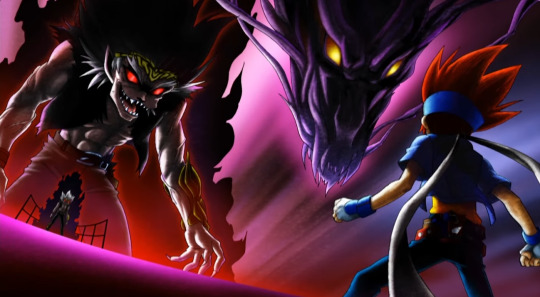
Key concepts: Vampires (and sometimes other monsters!) in works symbolize a variety of evils-- especially exploitation, corruption, and violation of autonomy.
What's this? Read the series intro post.
I'm sure I don't have to spell out why Lightning L Drago-- a bey that explicitly feeds off the negative emotions of its opponent in order to make itself stronger-- is the topic of an essay on vampires in media. It doesn't really get more on-the-nose than this. Truth be told, I wracked my brains for ages trying to find a more subversive answer to the question of "Who are the vampires in MFB?" but it feels wrong to cover this topic and not talk about L Drago and Ryuga. What I've landed on is the expansion from L Drago itself to the important figures of the Dark Nebula as a whole: L Drago, Ryuga, and Doji, and the characters who fell victim to the organization.
(I did also consider Reiji, but for the sake of brevity I will save discussion on him for another essay. His theming doesn't fit as neatly into the points being made here today).
Luckily, there is more to the metaphor than immediately meets the eye. The goal of this essay isn't so much to prove that the Dark Nebula represents vampirism, but rather to view it with this lens and explore the implications for the characters involved.

Foster in his book describes several facets that make up the literary vampire, similar to the components of the archetypal quest I discuss in chapter 1. Necessarily, there must be:
A (usually alluring) figure, representing some kind of corrupt value. This is our vampire
A victim for the vampire to feed off of
Within the story, the following things must happen:
Stripping of the victim's vitality
Continuing/enhancing the life of the "vampire"
The destruction of the victim
With these in mind, we can examine the Dark Nebula and its victims in the context of vampirism.
The Alluring Figure
There's a reason Dracula and other famous vampires have been described in their respective media as deeply attractive; in order to seduce a victim into falling into their traps, vampires must have some sort of draw. L Drago's allure is clear from the start: from the very beginning of its history, L Drago has drawn in bladers with the promise of near-godly power, one that can win wars and manipulate nature itself. Doji describes this briefly with Ryuga's introduction, and Ryo goes into further depth towards the end of the season.
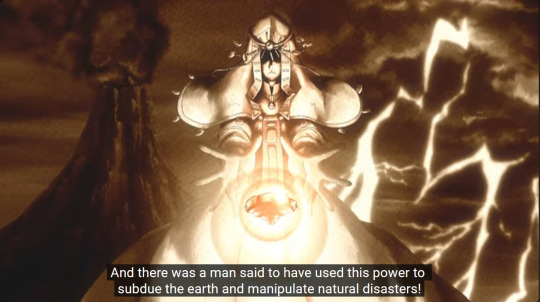
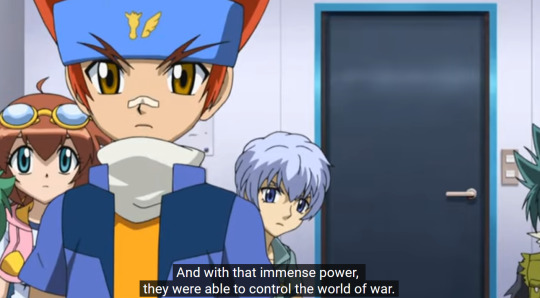
Like a vampire or other monster, the power is supernatural, otherworldly. L Drago literally is born of a star fragment that comes from the sky, and these origins play a role in its mystique. This mysteriousness then increases its draw-- people are attracted to the unknown even if they fear it, and L Drago is no exception. Though L Drago is ultimately created by humans, its basis is a power that humans didn't fully understand but are nevertheless enchanted by and use for nefarious purposes.
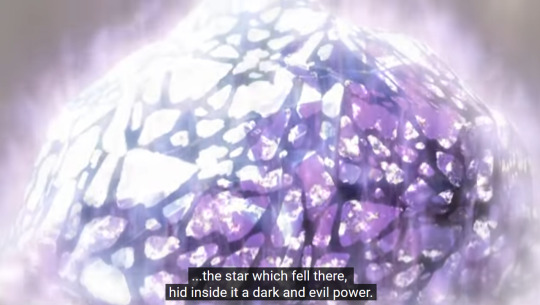

This extreme and unadulterated power is, of course, very corrupt and the show makes that extremely clear. The power is derived from negative emotions and thus inherently thrives on discord-- it can't coexist with peaceful times. That is why it was sealed away, and why legends warned against it. However, the temptation for power and control is too great, and that's why L Drago appears again and again through history. Doji even explicitly says "Whoever controls the extraordinary power of beys controls the very fate of the world itself" when monologuing during L Drago Awakens!
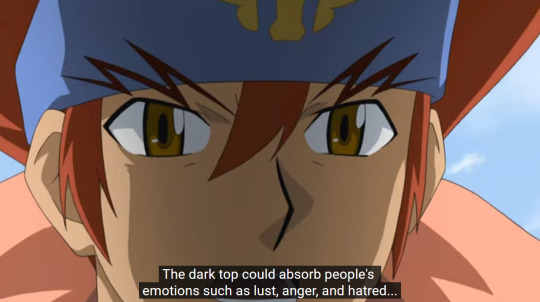
Similarly, Ryuga himself is cloaked in mystique for nearly the entirety of MFB; in Metal Fusion, we know very little about his past, his motivations (aside from the simple goal of wanting to be strong), or even his personality beyond his arrogance. This, combined with being the primary antagonist in season 1 and one of the canonically strongest bladers in the series, has made him a fan favorite.
Even Doji has a sort of charismatic appeal to him. He presents characters with a vision and promises it to them if they join his cause. For most recruits, this involves the promise of the power to beat Gingka (the main exception is Yu, and he is promised exciting battles and strong opponents. Thematically it actually makes sense that Yu is the only one of the Dark Nebula bladers to leave and join Gingka's side, as he is the only one is is not seduced by the power of raw strength, and has motivations far more pure than the other members-- that is, the joy of blading). Doji is also well dressed, well spoken, and careful about appearances; all these things draw characters towards him and make them trust him enough to join his cause. To join Doji is to make a deal with a devil in disguise, but the Dark Nebula recruits have no way to know this until it is too late.
Together, Doji, Ryuga, and L Drago all have a distinct appeal to them that draws people in; that being said, they are the villains of the show and very clearly represent the corrupting nature of power. They value power above all, and don't care who they hurt in the process of acquiring it. I'll speak later on the nuances of L Drago's influence vs the innate nature of the characters, but for now, consider them as one unit.
The Victim
A monster must have a victim, and the Dark Nebula and L Drago are no exception. Like a vampire, L Drago feeds off of the power and strength of its opponent, and once defeated, leaves them as a husk of their former selves-- drained, exhausted, and unable to do much of anything. In literature, the victims of vampires are usually young, innocent, and typically female; this is because vampires are often commentaries on exploitation and power imbalance. These themes run clearly through Metal Fusion as well.
The show depicts in no uncertain terms what happens to those who fall for the Dark Nebula's allure. Their strength is taken indiscriminately as fuel for Ryuga and L Drago, and Doji facilitates the destruction with a smile on his face. We see this with Tobio, Tetsuya, Dan, Reiki, and the Kumade brothers in The Dragon's Punishment.
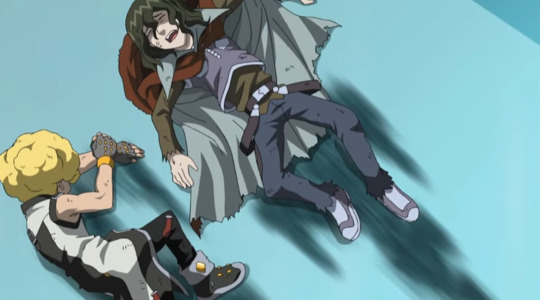

This display of power is shown to Yu (and Ryutaro) specifically, and though Yu isn't one of the people to be directly 'consumed' by L Drago, he fits the bill well for a vampire's victim-- young, naive, and caught up in things he doesn't understand. And despite not being a direct victim of L Drago, he doesn't walk away from his close contact with corruption unscathed; when he escapes the Dark Nebula, he is rife with physical injury, deep seated fear and despair, and his bey itself is badly damaged (which is significant as the state of a bey is closely in line with that of the blader's spirit. This is why Poison Serpent's physical chip damage is so detrimental for its opponent's mental states).
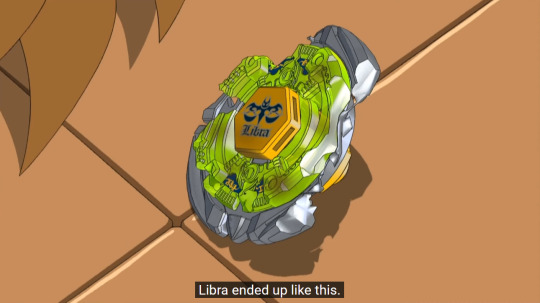
Apart from the Dark Nebula bladers, there are 3 characters who fight Ryuga directly during the Battle Bladers tournament: Hikaru, Tsubasa, and Kyoya. The degree of their post-battle psychological impact is interestingly in line with how much they align with the archetype of a classic vampire's victim.
I'll start with Kyoya, as he is the farthest removed. Kyoya is no stranger to conflict and he, like many of the Dark Nebula bladers, is driven by the desire to beat Gingka. However, his lust for power is addressed early on in the season when he has a brush with Doji himself; during those episodes, he's driven by an obsessive need to destroy Gingka. It's only when he undergoes personal growth during that battle do his motivations crucially shift-- at the end of the episode, he no longer sees Gingka as an opponent to destroy, but instead a rival to aid in their mutual growth. By then, his character growth arc is actually mostly complete (even if his power continues to increase). The Kyoya who goes to battle Ryuga is self assured and can no means be described as innocent or helpless; he is the one who ends up putting up the strongest fight of the three (it's implied that their strength is equal; the only reason Ryuga wins in the end is because L Drago begins to take over). This is why, when we see him again in Metal Masters, he bears no real evidence of the dark power's effect. It's honestly a stretch to call him a victim at all, especially when compared to Tsubasa and Hikaru.
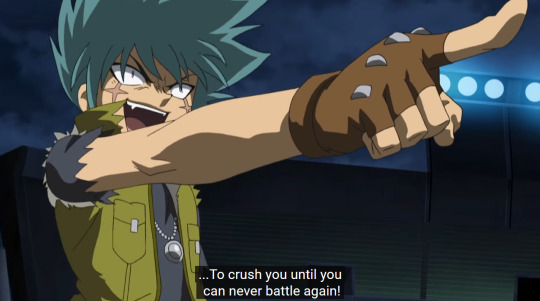
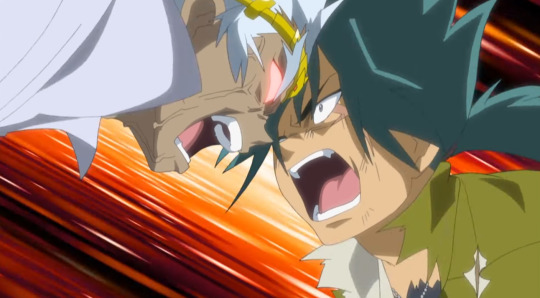
On the other end of the spectrum, we have Hikaru, who aligns far most closely with the archetypal victim. At first glance, Hikaru and Kyoya are similar in nature if not in actual power. Hikaru is also headstrong, passionate, and by no means helpless-- no one who made it into Battle Bladers is weak, and from her introductory episode Hikaru is a force to be feared.
Well. Or so we're meant to think.
I apologize for straying from the voice of an objective analyst for a second. I need you to believe me when I say it really really pains me to say what I'm about to say. Hikaru's fall off is genuinely one of the most upsetting things about this show to me. I love her and her character and goddammit she deserved better even if her fate makes sense thematically.
Hikaru isn't weak, but she is almost immediately outclassed after her initial win against Kenta. Kenta himself is the one to beat her in the very next episode. After that point, Hikaru does not win a single other on-screen battle for the rest of the season. For god's sake she even loses against Teru, a character who exists for like 5 episodes max.

Thus it comes as no surprise that, of all of Ryuga's opponents (after the Dark Nebula lackeys of course), she is the weakest.
It's also easy to miss Hikaru's innocence at first glance; after all, she has an intentionally cold and no-nonsense demeanor to hide her true feelings. It's only when Hikaru is training alone that the audience gets a real look at her motivations, and they are shockingly sweet. Her pursuit of strength is in service of her mother's dying wish. She made a promise as a child, and it is that childlike innocence and belief that drives her forward.
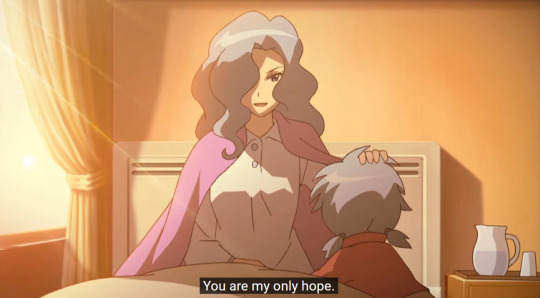
Like others, she also wants to be the best in the world, and she is willing to fight indiscriminately to get there (we see this when she is willing to fight Kenta posing as Gingka-- she doesn't care that he's just a kid, only that he is strong and defeating him will bring her closer to her goal). But beneath it all is the little girl who made the promise to her dying mother.
Unfortunately for Hikaru, this innocence further primes her to be the victim in our vampire's tale.
There is also discussion to be had on the fact that the only girl to enter Battle Bladers is the one to suffer the worst at the hands of Ryuga and L Drago. Whether or not this was intentional, the fact remains that she was sent crashing through the stadium, rendered helpless for the rest of the season (as were Kyoya and Tsubasa, but because Hikaru battles first she is out for the most episodes), and subsequently suffers such trauma from the ordeal that she gives up blading together. She isn't even given a chance to fight back before Ryuga defeats her with overwhelming strength and consumes her spirit. This could be read as an allegory for assault (and the underlying theme of sexual exploitation is seen often in literary works on vampires), but in an effort to keep the essay minimally triggering I won't speak further on this.


Tsubasa's case is a little trickier as it lies somewhere in between Kyoya and Hikaru. He's an exception to the other Dark Nebula bladers as he only joined in order to extract information on behalf of the WBBA. He wouldn't be blamed for dropping out of Battle Bladers altogether, and only battles Ryuga in a noble (if borderline self-sacrificing) move to ensure that others aren't hurt after what happened to Hikaru. Despite being a spy, he's an honest and level-headed person at heart, and battles with a cool rationality different from most others. Despite this, he is also severely victimized following the battle against L Drago. Why?
Tsubasa's backstory and personality is explored more in the second season with his descent into darkness, but we learn his own heart houses two key things that allow him to fall victim to the allure of power: a deep-seated insecurity about letting down those he cares about, and an lasting bitterness at people who are able to get ahead using underhanded methods. The dark power within him sells itself as a means to rise beyond these perceived weaknesses, and it's a struggle that lasts for much of the season.
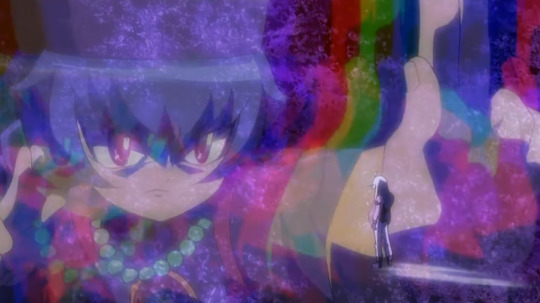

(sorry for the lack of subtitles the subbed version for Metal Masters just isn't available even with VPN for some reason and the auto-generated ones are incomprehensible)
These insecurities are shown to stem from his childhood, and the dark power taking advantage of this is what leads to his unwinding throughout the course of Metal Masters. His arc is to reconcile the conflicting parts of his personality, but as far as his interaction with Ryuga is concerned, the damage is done. It doesn't help that Ryuga is also able to overwhelm him with strength; though Tsubasa puts up a better fight than Hikaru, it is still no question that Ryuga is stronger.
If Hikaru's spirit is broken completely and Kyoya's is functionally unscathed, Tsubasa's can be argued to have fractured during this battle, and the exploration into his psyche later on also shows how he overcomes this trauma and is stronger after the fact.
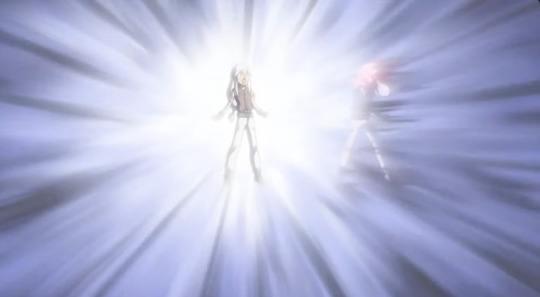
All of Ryuga and L Drago's victims suffer in different ways but the thing they all have in common is this: at the end of their battle, they are defeated and their spirits used to make L Drago stronger. Just as a vampire drinks blood from its victim to replenish its life, L Drago uses others' spirits as fuel to increase its own power.
There are two victims I have yet to talk about though: Doji, and Ryuga himself.
Doji is simply a victim to the power he helped create. In his devotion to Ryuga's rise to power, he forgot about the very thing he told Yu: under the Emperor, all others are equal. He thought because of his position as a loyal servant, he would be spared and he and Ryuga would rise to the top together. However, Ryuga discards him the second he stops being useful and shows weakness. It is poetic justice to see the very power Doji weaponized and directly nurtured be the thing that defeated him in the end. It plays right into the central theme as well-- that unchecked power is a corrupting force that spares no one.
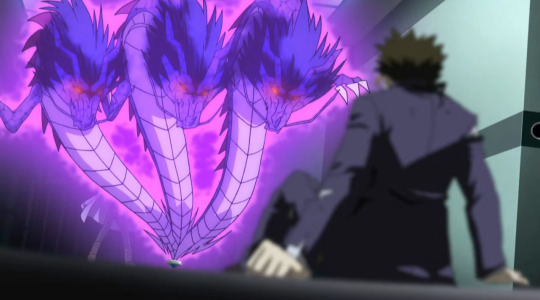
(The three dragons and Doji's helpless posture here mirrors that of Hikaru in her battle-- another neat detail that really hammers in the karmic nature of Doji's demise).
Ryuga's case differs from Doji, though. Unlike Doji, Ryuga was the one actually wielding L Drago and therefore directly suffering the corrupting force of the dark power contained within. We know that L Drago takes the negativity of a person and amplifies it, and we see this change happen in Ryuga as the season goes on. When he steals the bey with Doji, he is arrogant, yes, but does not have a god complex. He is also callous and mean, but not cruel until he gets his hands on the bey itself. When he first picks up the crystal, he explicitly says that he's aware of the power sucking him in and even looks alarmed, but his desire for power causes him to take the bey anyway.

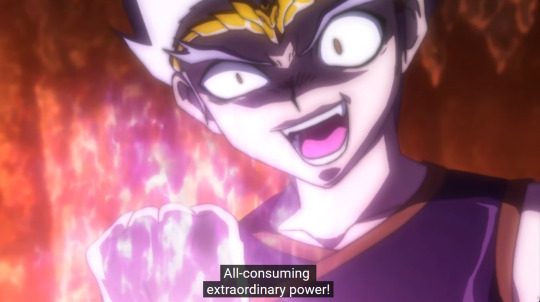
By the end of his battle with Ryo, he's already condescending Ryo for being too weak to fight against him. When he sees Gingka in L Drago Awakens! he intentionally insults Ryo to Gingka's face as a cruel way to provoke him. By the time Battle Bladers happens, he truly believes himself to be infallible.
In fact, he plays so neatly into L Drago's hands that it's only when he's in danger of losing to Kyoya do we realize that Ryuga isn't fully in control. In fact, Ryuga himself is consumed by L Drago before the match with Kyoya even ends. Again, in a scene that hauntingly mirrors Hikaru's, his own bey deems him too weak and turns on him. Just as Ryuga had discarded everyone weaker than him up until this point (including Doji), L Drago decided that Ryuga was too weak to continue, and pushes him aside, taking his power and his body to continue fighting in the name of world domination. It happens so suddenly that everyone, including Kyoya, Gingka, and his friends can only watch on in horror as it happens. They don't comprehend it until the final battle with Gingka, but this was the moment that Ryuga was lost and L Drago had fully taken control.
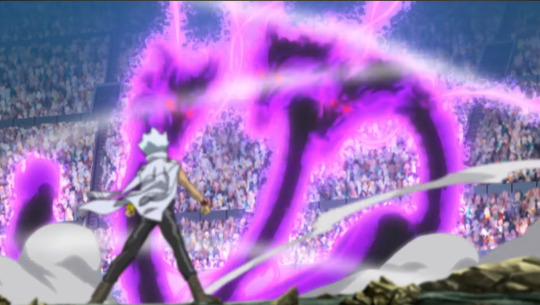
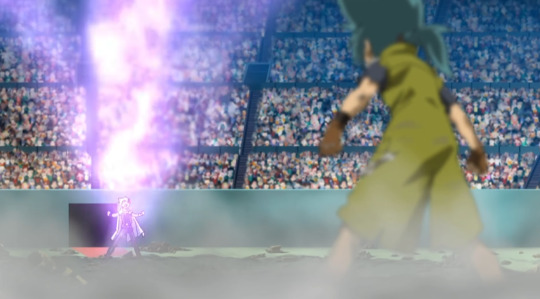
It's a clear violation of Ryuga's autonomy. It's unclear if Ryuga is aware of what's going on-- I'd argue that he is, as he has not fully changed into the monstrous form we see in the following episode, and even when he has transformed, Gingka is able to get through to him. L Drago consuming Ryuga and assuming control of his body is even more disturbing when recalling that a bey is supposed to be a blader's partner; this makes it clear that L Drago held the cards all along, and the relationship between it and Ryuga was never equal. To L Drago, Ryuga was always a means to an end. In other words, a thing to be used.
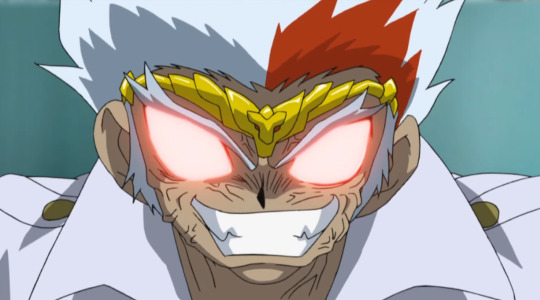
Kyoya's defeat is the most gruesome because he is L Drago's victim, not Ryuga's. If there was ever any doubt as to this fact, the animation makes it clear: Ryuga no longer appears human, and it's a head of L Drago that pierces Kyoya's chest and drains his energy.
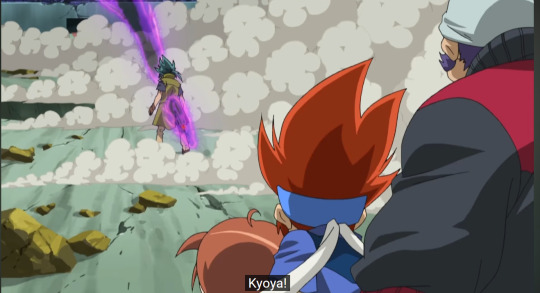
Ryuga, for all his cruelty and pride, was not the type of person to hurt a fellow blader in the way that happens to Kyoya. In the end, he fell victim to L Drago just as much as the rest of them, and that is why it is so important that Ryuga also be saved in the final episode.
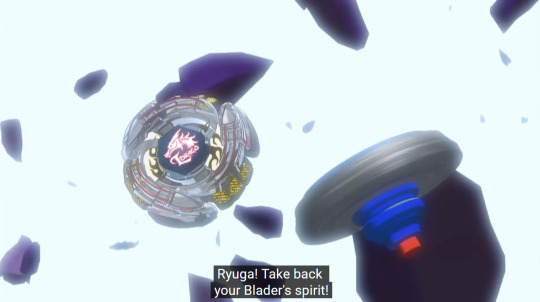
It's bitter irony that Ryuga says this line, when the real trap all along was L Drago's promise of power. Ryuga's arrogance causes him to fall for it hook, line, and sinker.
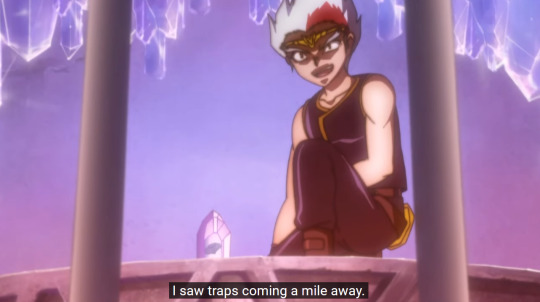
With the final two victims in mind, the thematic narrative is complete. Everyone who comes into contact with Lightning L Drago suffers for it. It draws people in with its mystique and the promise of strength, and then hungrily consumes the spirits of every blader it meets-- including its own master-- in order to make itself stronger. Lightning L Drago represents the simultaneously attractive and corrupting nature of extreme power. It's a force of destruction, and left devastation in its wake. It is a very small, very evil, left spinning little vampire.
Thanks for reading as always! I haven't yet looked ahead at the next chapter-- I try not to read them until I've finished the previous analysis. I hope this one was worth the wait. My personal life is busy as always but I love this little side hobby so much.
Want to read more? Chapter 1 Chapter 2
#the chapter on this topic in HTRLLAP goes into a lot of depth about non-literal vampires and other monsters#but frankly between med school and my upcoming usmle exam#i've chosen not to veer too far away from the metaphor of vampires themselves.#speaking of which it's like 2 am i need to go to bed i have an exam in like 7 hours that i have not even attempted studying for#HTRMFBLAP#beyblade#beyblade metal fight#mfb#ryuga beyblade#doji beyblade#yu tendo#hikaru hasama#tsubasa otori#metal fight beyblade#beyblade metal fusion#beyblade metal saga#character analysis#media analysis#beyblade analysis
22 notes
·
View notes
Note
Hello! Have you ever noticed the parallels between Kenta saving Benkei in Episode 9 and Ginga saving Kenta in Episode 1?
Hello!
More than a parallel, it's (for me) the highlight of Kenta's evolution between the episode 1 and 9.
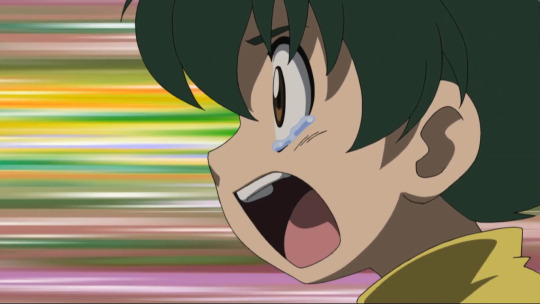
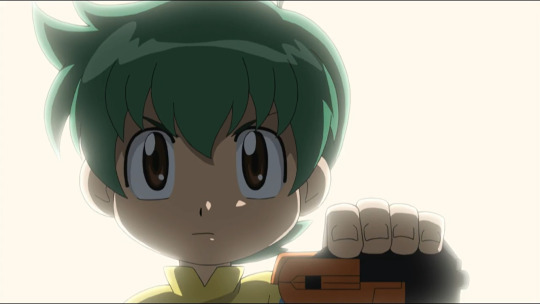
He and Benkei (who are mirrors in the first episodes) are characterized by an impressive growth in the first arc of Beyblade Metal Fusion.
About Ginga saving Kenta (episode 1)
This scene has for purpose to introduce the hero of the show. Kenta is a normal kid, with a passion for Beyblade, a couple of friends and big dreams. He's easy to identify with for viewers, or at least to watch fondly (contrary to Ginga, at this point, who keeps his distances with the other characters as well as the audience).
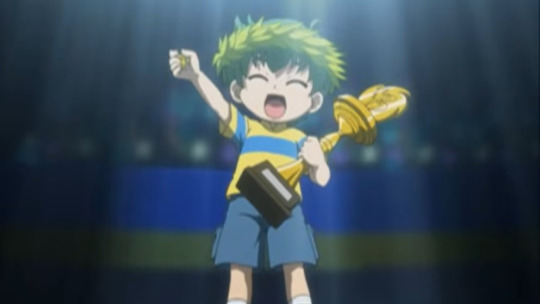
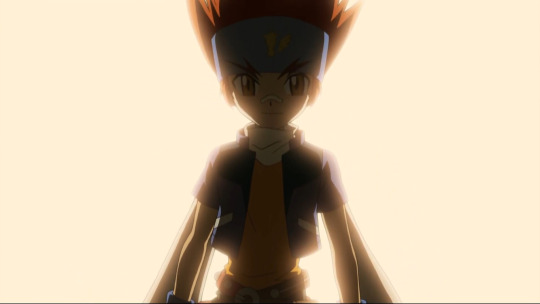
Kenta is attacked by the Face Hunters on his way home. He's forced to accept their challenge, knowing he'll lose, and is afraid the whole time (which is normal, one little kid cornered and mocked by a bunch of teenagers is bound to be afraid).
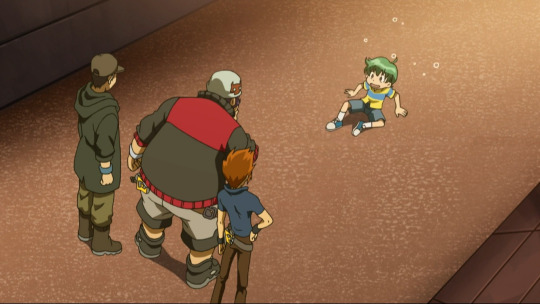
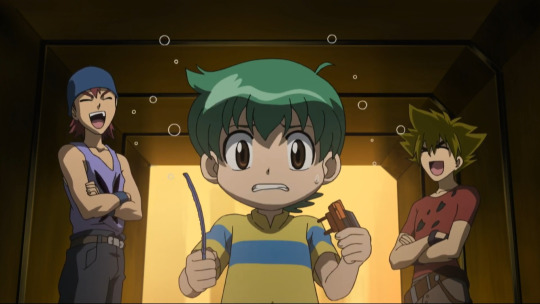
Kenta is good at Beyblade, since he won a tournament (as small as it is), but not strong enough to defend himself.
Ginga is a whole different category as a blader. He defeats easily Benkei and five Face Hunters, who are said to terrify the whole city. Him saving Kenta is followed by a victory even more impressive: the one against 100 Face Hunters.
About Kenta saving Benkei (episode 9)
Kenta does swoop in to save Benkei, as Ginga did for him. It not only highlights the fact Kenta evolved quickly in a short amount of time, but it also puts forward his courage (that showed for the first time to defend Ginga from Hikaru) and his forgiveness. Not so long ago, Benkei was the one bullying him like this and yet he does not hesitate to come to his help.
His entrance shows he's one step closer to his goal: becoming a blader like Ginga.
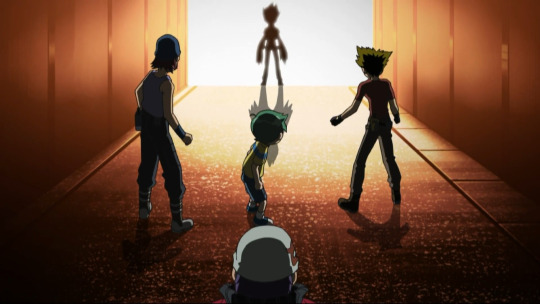
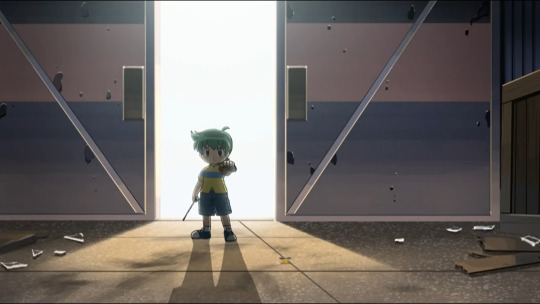
Closer... but not here yet. And he's aware of his limitations. It shows when he moves Bull away from Leone's path instead of trying to attack Leone directly. He knows he's no match for Kyouya.
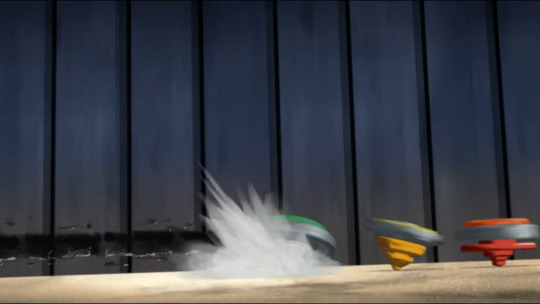
For a matter of fact, Kenta and Benkei lose. This defeat, however, doesn't point out their weakness, but Kyouya's progress as a blader after working with Daidouji and overcoming the Wolf Canyon.
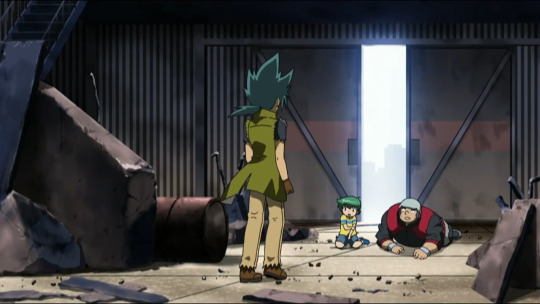

But thanks to Kenta's intervention, Bull isn't destroyed by Leone. Then, thanks to Benkei, Bull and Sagittario aren't crushed by Kyouya. Their teamwork and support allow them to avoid the worst for a blader: losing their beys.
#ask#mfb#kenta yumiya#kenta and benkei#mfb 1x01#mfb 1x09#comparison of scenes#kenta character analysis
16 notes
·
View notes
Text
Beyblade character design analysis: Tsubasa Otori
Link to the masterpost. I can't think of an intro so here's Tsubasa

Starting with the hair, it's long and silver. While this doesn't Eagle (the bey), it does match his eagle (the animal). The long hair also provides a lot of opportunities for the animators to show it flowing in the wind, which ties into his bey's abilities. And on a meta-level, silver-haired anime boys are typically portrayed as being really cool and mysterious. This fits Tsubasa quite well but is indirect enough that it doesn't tell us much (and Tsubasa's an undercover agent, so it fits him even better)
Tsubasa's shirt is brown with purple accents. The brown matches his eagle, while the purple matches his bey. The exposed midriff and lack of sleeves give off the impression that it doesn't protect one from the elements much. This fits Tsubasa, who thrives in nature. Plus the shape doesn't restrict his movements, fitting with his agile nature
He keeps his bey on his arm, rather than his belt like most bladers. His belt already holds his launcher, so putting the bey in there as well would result in it being quite bulky. Moving it to his arm instead allows his design to keep the agile image, while also giving his exposed arms more detail to avoid looking plain
Tsubasa's gloves remind me of falconry gloves, with the obvious difference being that they are fingerless. Fingerless gloves are a stable of beyblade's character designs, while the falconry glove aspects tie into his eagle motif. Plus Tsubasa has an actual eagle to the gloves serve a practical purpose
Tsubasa's belt holds his launcher. It's easily the bulkiest part of his design, but still sleeker than most bladers' belts, largely on account of his bey not being there. This feels more like a practical restriction, where ideally his belt would be even sleeker, but something had to give in order for him to store his launcher
Tsubasa's pants are unremarkable, but their slim design fits into the agile look I mentioned. The color choice provides some nice contrast to his dark top, which in a meta-sense, prevents Tsubasa from seeming like an overly edgy silver-haired anime boy (and instead just a slightly edgy one)
I have nothing to say about his shoes other than they match his gloves. It's consistent
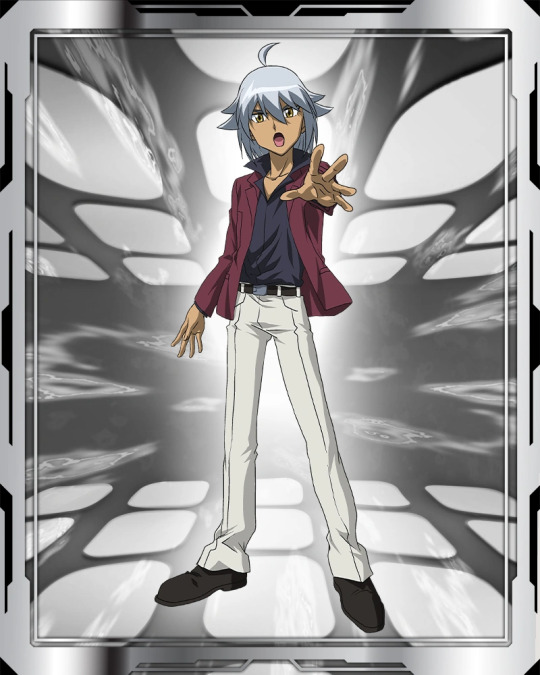
Remember Shogun Steel? Tsubasa's in it, with quite a different design. His hair is shorter, but is otherwise mostly the same. At this point, Tsubasa has lost all the mystery to him. We got to know him throughout the prior seasons, and with Shogun Steel's timeskip and new cast, he becomes more of a mentor figure
Tsubasa wears a black shirt that is far more formal than his previous design. It's still nor overly formal, but it fits the image the new cast has of him as the director of the WBBA
His red suit adds more detail, but doesn't reference his bey. This is partially because he's no longer an active blader, and partially because the only other executives with purple suits in mfb are Doji and the Garcias. Making Tsubasa's design resemble Doji, while not a problem, would've probably raised an eyebrow or two
Tsubasa's belt looks like a normal person's. Gone is the bulky blader belt, which again is due to him effectively retiring. He dresses like a normal person, which is extremely rare for bladers. This is further highlighted by the lack of gloves
His white pants are similar to his previous ones, but slightly more formal. Tsubasa hasn't changed much, but his circumstances did. He's a retired blader and WBBA director, but unlike Ryo, his personality stayed basically the same
His shoes are just as unimpressive as 90% of characters I've talked about here, but they are formal, and more importantly, look like something a real, normal person would wear. Turns out the best way to hint that a blader retires is to have them dress like a real person. Who would've guessed
11 notes
·
View notes
Text
it has been 5ever since i saw fusion so i dont remember every exact detail about tsubasa's character but i do believe tsubasa's experiences and arc in masters is a continuation of how tsubasa's beliefs about beyblade and the blader spirit from metal fusion change. i think it's very possible to write like heavy video essay analysis on tsubasa but again it has been 5ever since ive payed heavy attention to his character so i am not the best person to do it right now lmao but i still want to write some thoughts down
in fusion, tsubasa was confused/struggled to understand the friendship bit when it came to beyblade. he was mostly concerned about keeping the peace/legality of Beyblade because he was sent as an agent by the WBBA to stop ryuga (iirc). tsubasa didn't understand why all of gingka's friends stood in front of him to prevent him from meddling with gingka gaining enough points to compete in battle bladers. i dont think it was until he was hospitalized in fusion and later he and the rest of the ryuga trauma trio (hikaru kyoya tsubasa) shielded gingka during his battle with ryuga that he understood the importance of friendships when it came to Beyblade (again i havent seen fusion in a while i could just be liek making shit up in my brain)
like the rest of the ryuga trauma trio, he was horribly defeated by ryuga in fusion and doesn't want that to ever happen again. in masters, tsubasa is dealing with his fears of failure and now a fear of inadequacy and bringing his team down now that he has relationships he's made through beyblade and it manifested through the fraction of the dark power that ryuga left him. it caused him to doubt himself, make rash decisions, and avoid his friends. he had to confront his emotions, remember to be confident in himself again, and believe in his friend's support in order to pull himself out of those thoughts. i want to note one of my favorite battles (probably my favorite battle in masters) which is Argo vs. Tsubasa. not only was it like really fucking cool but we see a tsubasa who has "beaten" the dark power almost slip into his previous headspace again, but he's brought out of it after his team cheers him on. this battle is soooo important to me and to tsubasa and it really showcases how far he's come from fusion. it highlights the all the hardships he's gone through and the importance of the friendships he's made.
okay i MIGHT have gone off topic from what this was all originally about and i could've worded things better methinks BUTTT whateverrr i have been thinking about tsubasa a bit recently this gives me an excuse to type about him. hes def in the top 3 best written mfb characters. i think it's just up to personal preference if you wanna say number one is masamune or tsubasa imo #lol
out of any character to fill the shoes of this sort of arc, i think tsubasa was the best choice to go through it. he has that aura of mysteriousness still from fusion so it mightve been a bit odd to see kyoya go through it, especially because he already sorted out issues during his dark nebula and wolf canon era. though i think hikaru wouldve been also a good choice to go with if she was on gangan galaxy instead
i think i've talked abt this before on discord but like, i don't Get tsubasa's dark power arc i think. i just... don't get how it pertains to tsubasa as a character. even after rewatching s1 i still don't get it. like, okay, we have a few different concepts to work with here.
how and why tsubasa got the dark power
the dark power as a desire for power and winning for the sake of winning
a secret third thing that is largely irrelevant to our discussion (and largely nonspecific to tsubasa or the dark power, though frankly the dark power is a very nonspecific thing anyways) but it exists and i can yap about if prompted (warning: i WILL get very off track)
when i first watched metal masters, my assumption was that tsubasa got the dark power because he was involved with dark nebula. this would sort of make sense but also not really, seeing as how he wasn't actually on their side. this interpretation is seemingly completely unintended, but i kind of prefer it to the actual explanation, which is that tsubasa... got it from fighting ryuga?? because the dark power is like covid but really selective i guess.
this brings us to the question of why tsubasa specifically, which is the big thing that's hanging over this whole arc for me.
so like, for tsubasa the dark power is all "GRAHHH i must WIN!!!!!" right? but that's... not relevant to tsubasa's character up to this point at all. his focus on things such as getting stronger and winning are generally at a pretty normal level generally, and while there are a couple possibilities here... both of them are quite clearly not the case.
first up, seemingly the most tsubasa ever cares about winning in s1 is when he's up against ryuga, which is reasonable given that he's a major threat. so, maybe frustration at not being able to stop him, right? the problem here is twofold. while certainly a lot would have been avoided if tsubasa was able to defeat ryuga before battle bladers, that fight is not the root of the dark power. instead it's the one during battle bladers, where kyoya was the only one to get obliterated by ryuga afterwards (and benkei i think but also the show doesn't count him as part of the Getting Beat By Ryuga Club)
secondly, this is not a situation tsubasa is put through in baku- by the time a threat like ryuga pops up again his arc is over and he gets basically written out of the rest of the season. and of course, as i said, the dark power is about winning for the sake of winning- not something tsubasa particularly cares about.
the second possibility i only thought about during my rewatch of s1 and frankly would've been an insane move for this show (albeit a potentially really interesting one)
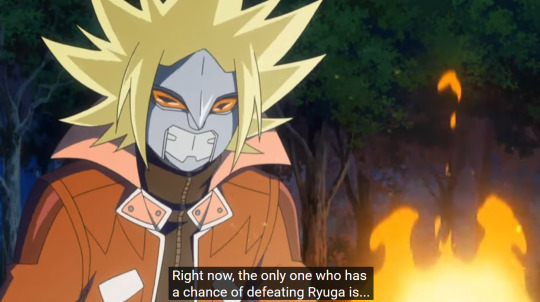
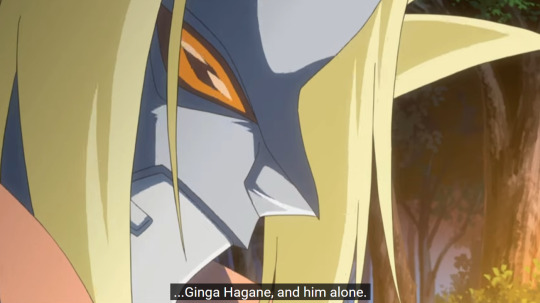
i think if i were tsubasa and someone told me this only to find out later they were talking about their son i would have turned them into a pile of blood on the spot. of course this is quite clearly not what the writers were going for, because if it was we would've seen tsubasa lash out at ginga, and also i just don't think the writers would do this especially considering fury.
i kinda had more when i first started writing this post but i had to go eat dinner partway through writing it and forgot some of what i was gonna say, or atleast how to say it. oops.
#tsubasa yapping hours#inserting my 4 year old tsubasa fan self into this for real#metal fight beyblade#tsubasa otori
25 notes
·
View notes
Text
A critic of the Legendary Bladers concept.

The concept of the Legendary Blader is central to Beyblade: Metal Fury, playing a significant role in shaping the third part of the MFB series. Through this, new characters, themes, lore, and ideas were introduced. In this analysis, I will explore the Legendary Blader concept by focusing on three key points.
The star fragment and bey obsolescence
The Star Fragment is obviously a central element for the Legendary Bladers, as it is what sets them apart from other Bladers. The Star Fragment serves as a convenient excuse to evolve the Beys of pre-existing characters: Gingka, Kyoya, Ryuga, and later Kenta. Evolutions in the MFB anime are actually quite rare. Unlike the manga, characters don’t evolve their Beys through progress or special events. In fact, it’s more common for a character to change part of their Bey (like Chaoxin), and sometimes characters even change them entirely (like Zeo and Toby). However, the latter case was due to their need for a fresh start after being subjected to Hades Inc. Masamune received an evolved version of his Unicorno thanks to Coach Steel’s modifications, but he did this precisely because he learned Gingka’s Pegasus had evolved and wanted to become a Legendary Blader. Finally, Ryuga was able to evolve Lightning L-Drago into Meteo L-Drago by conquering the dark power.
This illustrates that in the Metal Saga, Beys are an essential part of a character’s identity, and they don’t often change them. Beys are considered partners and are too deeply intertwined with the supernatural and the characters themselves (after all, the characters’ designs are based on their Beys) to be modified on a whim. For example, it would be strange for Kyoya or Gingka to ask Madoka to modify their Beys, given the values they hold for them.
This is actually a disadvantage for MFB, as the goal of the anime is to sell Beyblades. As a result, whenever you introduce a prominent Beyblade that you really want to sell, you have to create a new character. This might cause issues with character development, considering the number of characters already in the show and the limited number of episodes.
This is where the Star Fragment is a genius move: it allows the Beys of previous characters to evolve into the new 4D system. This way, they can present the new system as special. Additionally, it was already established that Beys are made of meteorite material, so a fragment of the same thing powering the Beys seems logical.
This doesn’t mean the concept is perfect, though. The first problem is that it is reserved for only a select few, and the evolutions only apply to pre-existing characters. This actually limits the new system to a handful of people: the Legendary Bladers, the Nemesis Bladers, Ryuto, and Masamune. The second issue is that it clearly sets these characters apart from all the others. Even though some of the Fusion characters were outclassed by Gingka and his group, as demonstrated in Battle Bladers, there was still hope for them to come back stronger and remain relevant in the show. After all, Tsubasa and Yu maintained consistent roles in later seasons, and Tobio even returned during the Destroyer Dome.
But now that we have a group of Bladers certified as the "strongest in the world" thanks to the Star Fragment, the hope for other characters to shine, surpass the Legendary Bladers with their own skills, or even create tension in a match has been demolished. The proof is that no Legendary Blader has ever lost to a non-Legendary Blader, and no holder of a 4D Beyblade has lost to a Blader with a non-4D Bey. For example, Yuki was able to beat Cycnus, and Johannes was able to outplay Dashan.
This perfectly illustrates what I call "Bey obsolescence," which refers to a new kind of Bey or system eclipsing the others within the same generation. For example, in Fusion, characters with Beys using plastic fusion wheels played a relevant part, yet in Metal Masters, these Beys are reserved for background characters. This kind of Bey was used by Kenta’s friends, whom we don’t see anymore after Fusion, as well as Hikaru and Hyoma. The latter two were strong enough to defeat Kenta at one point and participate in Battle Bladers, but they are the only participants of that tournament who have given up competitive Beyblading.
Of course, there’s the factor of their trauma, but Tsubasa overcame the dark power, and they could have had their roles switched with others in Battle Bladers. However, it didn’t happen, and I think the explanation is that it was simply convenient to reduce the presence of two characters using an obsolete system to make more room for new Bladers and Beys. As conspiratorial as it might sound, if you look at any team in the World Championship, none of them—not even Team Desert Blaze—used plastic wheels. This obsolescence is real, as seen in Zero-G, where the generic Beys use the Ray and Spiral fusion wheels, which were once used by prominent characters.
I think Metal Fury is painfully aware of this and tries its best to counteract it, mainly by showing close fights, like Gingka vs. Kenta in Beyster Island or Kyoya vs. Yu. In a way, it works. It’s almost impressive how these characters can hold their own with their Metal Fusion Beyblades against Legendary Bladers.Another point the anime insists on is that Gingka and Kyoya needed to learn how to use their new 4D Beys. Before their defeats against Ryuga, they often relied on mode changes, much like Johannes and the rest of the Nemesis Bladers did. It’s notable that Johannes, Pluto, Hershel, and Cycnus don’t have a special move, and for the latter three, they don’t even have a Bey-beast or aura. These are characters who over-rely on their Beys’ abilities rather than fully utilizing their potential. This is presented as the “wrong way” to use a 4D Bey. It’s also noteworthy that Kyoya and Kenta created their special moves by defeating one of these Bladers. So, in a way, the anime tries to tell us that while it’s great to have a powerful new Bey, if you just rely on mode changes, you’re not going to get very far.
So, even though the Star Fragment is a great idea for changing the Bey system, it kind of limits the possibility of characters benefiting from it. Especially considering that only four characters received drastic evolutions. It also confirms the tendency to leave characters behind, depending on their beys. Nonetheless the series finale addresses this issue by having all the Bladers transfer their power to Gingka.
The Legendary Bladers and Character Development
The second point that needs huglight is the legendary blader themselves and how they perforemd as characters. This is not about critizing the choice of these characters for the legendary blader postion but rather seeing if there is more to them than their title and if they are developped. Now characters developpment is all well and good but it is better if a charatcers is fleshed out so they can stand out more.
Gingka, Kyoya, Ryuga and Kenta
On the eleven people that received a star fragment only four were introduced in a previous season: Kyoya, Gingka and Ryuga and Kenta. All fo them were well established charcters and they all had their time to shine in the season. Kyoya had his little arc, Gingka put an end to Nemesis thanks to all the blader ijn the world and Ryuga and Kenta built a bond with each other. We actually saw more of Ryuga, how he trains and how he lives thanks to his tribulations. For Kenta this was the occasion to grow stronger but also distance himself from Gingka and the rest of the group, which allowed him to stand out more and gained independance. Bulding a relationship between Kenta and Ryuga was obviously surprising and welcomed. As the two had never really interacted with each other and are actually very different. We have Ryuga who was always strong and narcistic and Kenta who built slowly but surely his strenght and tries his best to help friends whenever he can. His journey with Ryuga is actually refreshing and unexpected. In my opinion it is the most succesfull things metal fury did. Reagarding their selections as legendary blader I think it what obvious they would be selected. Kyoya, Gingka and Ryuga are the strongest blader in the world with a lot of achievement to their credit like battle blader and tghe world championship. Kenta succeding to Ryuga as the lengadry blader of summer is a perfect consluon to his charcters journey not only in fury but in the whole series as well.
Yuki
Yuki was introduced very early in the season, being one of the first characters to appear in Metal Fury. Much like Kenta, Yuki starts off by being attacked, unable to defend himself until Gingka intervenes. They quickly become friends. After Kenta left the group, Yuki somewhat filled his role without replacing him. Yuki has elements that set him apart—he is determined, enjoys astronomy, and uses his passions to his advantage (like when he figured out how to open the door of Dynamis's temple). He is intelligent and loyal. However, his biggest weakness is his lack of confidence in himself as a Blader.
After he became a Legendary Blader, he participated in the Tag Team tournament alongside Gingka, and his confidence improved—a trend that continued over time. Overall, Yuki was a well-developed character; he had time to be properly fleshed out, and he actually grew during the season.
The main issue comes when it’s revealed that Yuki is a descendant of one of the Bladers who fought Nemesis in the past, which allowed him to gain the star fragment. Yuki’s reaction is one of pride and joy, as one might expect. However, for me, this was a missed opportunity for introspection. He’s supposed to be a clever and level-headed character, yet he never questions the influence of destiny on his life. Was he always destined to become friends with Gingka? Are his achievements only due to his ancestors? This could have led to Yuki affirming himself—not in opposition to his fate, but as his own person. This would have been a nice way to parallel Rago and Pluto, who mindlessly follow the prophecy of their own ancestor.
Aguma
Regarding the case of Aguma, I believe he also benefited from an earlier introduction compared to the other Legendary Bladers. He is also the first to join Nemesis, which sets him apart from the others. Aguma is part of the Beylin Fist, a rebel faction of the Beylin Temple. He wishes for his faction to get the recognition they deserve, which is why he allies himself with Johannes, who promised that in the "New World," the Beylin Fist would become the one and only school for Beyblade. This integrates Aguma and the rest of his clan into the world of MFB by using the pre-existing Beylin Temple.
Though Aguma does not develop a rivalry with Dashan, he does have an antagonistic relationship with Kyoya, which plays into Kyoya's solo arc. By being one of the antagonists during Metal Fury alongside Johannes, Aguma manages to stand on his own and gain some individuality. After his successive losses to Kyoya, King, and Tithi, as well as Pluto's betrayal, Aguma faces an internal crisis about what to do next: help the Legendary Bladers, do nothing, or side with Nemesis.
This moment of introspection could have been a positive turning point, if it hadn’t been interrupted in the worst way possible. Dynamis reveals that Aguma's ancestor sided with Hades in the past, before switching sides to join the Legendary Bladers after an encounter with Tithi's ancestor. Because of this, it feels like all of Aguma's choices have been dictated by fate, as he ends up replicating the same mistakes his ancestor did. This makes him seem more like a puppet of fate rather than a fully developed character.
King
King was introduced around the middle of the season. Like Yuki and Aguma, he participated in two tournaments, showcasing his performance to the viewers. The most important aspect of King is the friendship he built with Masamune. In my opinion, they complement each other very well, as seen during their battle against Hershel, and King quickly became a part of Team Dungeon.
Of course, King suffers from the same circumstances as the other Solar System Bladers, but what counteracts this is his genuine love for Beyblade, much like Masamune and Gingka. Additionally, his ancestry never got in the way of his actions or choices, and he didn’t seem to place much importance on it. Even if he wasn’t a Legendary Blader, he still had a unique Beyblade, Variares, that can spin in both directions, which already makes him stand out.
In summary, King is a very unique, iconic, and well-integrated character.
Dynamis
Dynamis first appeared in the arc just before the Beyster Island tournament, and he didn’t participate in it. Just like in the manga, he doesn’t have much screen time compared to the previous Legendary Bladers. I think this is due to the fact that his primary purpose is to deliver the lore behind the Legendary Bladers, making it harder to dissociate him from that role.
Later on, Dynamis gets possessed by a dark power, which might be an allusion to Tsubasa’s dark power arc. This is fitting since Zeus, represented by Dynamis's Beyblade Jupiter, has an eagle as its symbolic animal.
Dynamis’s main problem is that he doesn’t have any real meaningful relationships with other characters, making him feel more like a plot device.
Chris
Chris was also introduced fairly late in the season, but fortunately, he has a backstory. He suffered a similar situation to King, being ostracized and abandoned because of his strength, which alludes to the fact that Legendary Bladers in the manga aren’t allowed to participate in tournaments due to their overwhelming power. Unlike the other Bladers of the four seasons, Chris wasn’t introduced in previous seasons, nor did he have an impressive record before winning Beyster Island. He suffered from unfortunate circumstances that prevented him from going to the World Championship.
However, Chris brings with him an interesting concept—that of a mercenary Blader. This is relatively new to the series, and it seems to fit well in a world where Beyblade holds such a significant place. It’s almost strange that we didn’t see more variations of what a Blader can do outside of just fighting in tournaments. Unfortunately, this concept was introduced far too late to be fully explored, especially considering Chris seemingly gives up the mercenary way. After he lost to Gingka and sided with the Legendary Bladers, it appears Chris turned over a new leaf, but since this happened just before the final fight against Nemesis, we didn’t have enough time to appreciate his development.
Tithi
Tithi was the last Legendary Blader to be introduced. What’s original about his introduction is that, unlike the others, he isn’t found by Gingka but by Kyoya and Yu. From the start, we get a good sense of his personality—he’s a shy kid who just wants friends to play Beyblade with, a feeling Yu understands well. Their bonding was very sweet to watch and helped reintroduce Yu into the new season.
During battle, we see that Tithi has a joyful personality. He can be unpredictable and a little wild at times. Of course, who could forget him annoying Kyoya by calling him "Tatakyo/Yoyo"? Tithi later battled Aguma, which contributed to Aguma's doubts (along with Pluto’s betrayal).
Overall, I think Tithi was fleshed out well, but the problem is that he was introduced so late in the season that it feels like he was mercilessly thrown into the Nemesis crisis. Think about it—he was just a little kid minding his own business, finally finding a friend to play Beyblade with, and less than two days later, he’s forced to face this universe's version of Satan. However, his potential was clearly wasted, especially considering he stayed with Dynamis, with whom he had almost no interactions.
Rago
Rago is one of the main antagonists of Metal Fury, and he is also the only Legendary Blader to be truly evil. He appears in the latter part of the season, which seems at odds with how the anime presents him—as the ultimate villain Gingka and the rest must face. Rago is merely the man who wields Nemesis, nothing more and nothing less. He shares similarities with previous main Blader antagonists like Ryuga and Damian by being narcissistic, boastful, and insulting. However, Rago's issue is that he didn’t have the same buildup as Ryuga did in Metal Fusion. He feels like a character pulled from a catalog, especially considering that he appears alongside the Nemesis Bladers.
Though he endangered the entire world and kills Ryuga, there’s no progression to his evil actions. The problem is that we already know he wants to destroy the planet and end all life. In contrast, Ryuga's actions in Metal Fusion became increasingly unhinged, making us fear and anticipate his next move. However, Rago has something that sets him apart from other villains—he's not Gingka's villain but Ryuga's. There isn’t much of a parallel between Gingka and Rago. The Legendary Bladers of the Solar System, much like Rago, are bound by fate, while Ryuga is different.
Ryuga wanted to bury his past in the Dark Nebula, particularly the time he was possessed by L-Drago. Then, in Metal Fury, Doji returns alongside a new Blader who controls a seemingly unstoppable dark artifact that just absorbed L-Drago’s power. Ryuga feels insulted, but the main reason he fights Rago is because he sees himself—Metal Fusion Ryuga—in him and wants to destroy that part of himself. Additionally, Rago is a threat to his supremacy in the Beyblade world, so if Ryuga wants to live up to his title, he must either fight him or die trying.
Overall, I think Rago is a pretty solid antagonist. He serves his purpose, and while his fight with Ryuga meant more for the latter’s character, it allows Rago to be more integrated into the story.
Most of the new characters who became Legendary Bladers serve their purpose well; they are unique characters. Some are more integrated than others into the wider MFB canon. However, they all would have benefitted from more time to be fleshed out, particularly Dynamis and Chris. The new lore surrounding them adds more substance to the series, but at the same time, the over-reliance on it and on fate hurt some of these characters badly (like Yuki and Aguma). The main problem is that Metal Fury was 12 episodes shorter than the previous two seasons. With that amount of additional episodes, the new characters could have benefitted greatly from further development. In summary, this is a big waste of potential, and most of them don’t succeed at being more than just Legendary Bladers.
Gingka Hagane and the concept of fate.
The concept of fate and supernatural forces has always been present in Metal Fight Beyblade. In Metal Fusion, we had Ryutaro, who had visions about the future, while in Metal Masters, Julian and Damian used a vague concept of fate to justify their positions and why they should win. Despite this, Gingka was able to beat them all and even overcame fate. Ryutaro had a vision of an apocalyptic future, but after his losses to Gingka in Battle Bladers, he saw that a different path was possible. Madoka's computer predicted that Gingka had less than a 1% chance to win against L-Drago, yet he succeeded. Finally, let's not forget that King Hades' prophecy hadn’t fully realized itself because Gingka and the whole world defeated Nemesis. The point is that Gingka has a habit of triumphing over fate and preconceived ideas. For him, being a blader is about fighting with his heart, loving his Bey, and getting back up when he loses—it’s how he becomes powerful. Yet, in Metal Fury, some of the most powerful bladers are those who have special ancestors and a star fragment in their Bey. The reason the star fragment chooses those particular bladers is related to fate, as the attribution was tied to the prophecy and is known by Dynamis. This use of the concept of fate and predetermined power in Metal Fury fundamentally undermines the themes that were built in previous seasons of Metal Fight Beyblade. Gingka’s story in Metal Fusion and Metal Masters was about defying odds, challenging fate, and rising through sheer willpower and love for the sport.
The concept of the Legendary Blader brought some fresh elements to Metal Fury but ultimately constrained the series. While it introduced new characters and deeper lore, the overreliance on fate limited the potential for character growth and reduced the tension in battles. Characters like Yuki and Aguma were overshadowed by their predetermined roles, while others, like Dynamis and Chris, suffered from lack of development due to the shortened season. While there were positive developments, such as the evolving relationship between Ryuga and Kenta or the bond between King and Masamune, Metal Fury ultimately fell into the same trap as its predecessor by superficially handling an expanded cast. The season reflects a broader fatigue with the Metal Saga, struggling to balance the introduction of new elements with the need for meaningful character development.
#metal fight beyblade#mfb#gingka hagane#metal fury#kyoya tategami#ryuga beyblade#chris mfb#tithi beyblade#dynamis beyblade#kenta yumiya#yuki mizusawa#aguma beyblade#king beyblade#masamune kadoya
80 notes
·
View notes
Note
Masamune is your favorite character? Why so?
Sorry for the late response. Life got really hectic this week.
Masamune... Well, I find his confidence endearing. It's arrogance, really, in the beginning but I like it once he's been humbled. It has a strange charm to it I guess. I suppose I wish I could have that kind of confidence in myself — not the arrogance, but the genuine, healthy confidence he gets in the second half of Metal Masters. That confidence, paired with how persistent and hardworking he is, is quite admirable.
I also really like how much heart he puts into everything. Whenever he tries something, he gives it his all, be it training or actual serious matches. You can tell that he's really into whatever activity he's participating in all the time, which is also an inspiring quality. I really admire people who can be fully content with themselves without forcing themselves to fit into any kind of mold.
But when it comes down to it, what I love the most about him is how much he cares about his friends. Sure he makes some bull-headed decisions that come to bite him back but I believe it's the intent that counts. This kid, who could hardly be older than 15 or 16, literally travels across the globe to find Gingka and defeat him, just so he can keep his promise to his dying friend. Is it the best decision he could make? No. But it's still something he does out of loyalty to his friends.
It's not just that one instance either. Most of the rash decisions he makes in the series is based on what he thinks will benefit his friends the most.
He challenges Gingka hundreds of times in the second episode of Metal Masters, because he thinks that's the only way he can keep his promise to Toby and Zeo.
He interrupts Gingka's battle with Dashan and accepts Gingka's ire in front of the enemy just to keep Gingka's skills a secret from Wang Hu Zhong.
He fights Klaus, a monster of an opponent, with no plan or prior discussion because he and Yuu are the only options they have.
He jumps into the fight with Enzo because he's pissed at everything Team Garcia has done to Yuu.
He even jumps into a battle with Ryuuga on the off chance that Ryuuga might be targeting Zeo for no reason, even if every evidence points to the contrary.
In Metal Fury, he rushes to the final battle at the Beyster Island tournament to fight Chris simply because Chris attacked his friends.
Of course, this doesn't mean that Masamune cannot be thoughtless and selfish. He has a lot of those moments as well, but when it comes down to it, he cares a lot.
Also, Masamune's character arc is really enjoyable to watch. The Masamune we're introduced to in S2E1 hardly feels like the same person as the Masamune we end up with by the end of Metal Fury, even if they still share some core character traits.
7 notes
·
View notes
Note
what are your top 5 favorite medias/fandoms that you're in atm?
Thanks so much for the ask!! My answers are probably not surprising lol. -<3 Gooseless
MFB!!!! Everyone is so so nice!! I grew up in this fandom and genuinely consider several people in it to be like family to me at this point. Seriously, some of the sweetest people on the planet and I absolutely love them. Also, I just genuinely love Beyblade so much. In particular, I really love making original beys!
Pokémon! I've always loved Pokémon, especially dark and ghost types. The bits of the fandom I've been in have been nice as well. I really enjoy making fan teams for non-pokémon characters too!
Sing!! Obviously, this is my Sing based blog so no one should be surprised by this addition. I've actually made several close friends through this fandom and I really enjoy being in it! I love being able to do scene analysis on the movies as well and creating backstories is tons of fun!
The Dragon Prince!!! Everyone I've talked to in this fandom has been so nice and welcoming. I love the differences in the different types of elves (looking forward to seeing Tidebound elves). I also love the world-building and it's really fun to build characters off of such a fleshed out world.
The Owl House!! Seriously super sweet people and super welcoming. I love the magic system and working with it a lot to apply it to non-owl house characters as well. It's super fun content and super interesting! It's super cool and easy to build character since there is so much information and world building, it's amazing!
#mfb raised me and I absolutely adore it. - the kid who calculated the location of a fictional country for fun#i do adore it tho#ive made so many friends there and in the sing fandom#im not really active in the other three fandoms but i check in from time to time#my blog names are actually a fanmade beyblade i made in grade school. hoperay pegasus#so yeah#random ask game time#it's learn about gooseless day everyone#by the way i utterly adore your fics#they are amazing!!#they're super fun and interesting and i always enjoy reading them
13 notes
·
View notes
Text
how vengeful gasher subverts the beach episode: a study on tetsuya watarigani
for mayblade day 8 - beach
i mentioned earlier today that because of ATLA the words 'beach episode' deal unfathomable psychic damage to me, and it got me thinking. ATLA's "the beach" is iconic for being a subversion of the typical beach episode, a trope which usually entails a bunch of characters from a show getting together in a low-stakes, kinda fanservice-y self-contained plot. they get together on a bright summer day and small shenanigans ensue, and by the end of it they all grow and get a little closer as friends.
beyblade definitely does have an episode like this: metal masters' "we meet again! wang hu zhong". team ggg train on the beach, get into mild conflict, meet with old friends, and come out of the experience smiling and having bonded as friends. we even get the characters dressed up for the occasion


do you know, however, what other episode takes place on the beach? episode 5 of metal fusion: vengeful gasher

if you are like me, vengeful gasher won't even really register as a beach episode to you at all. sure it takes place on a beach, but it is so far removed from what a beach episode typically entails that it's hard to call it one. i'm going to argue, however, that this is what makes the episode compelling to study in this lens.
(for the purposes of this analysis i'll be talking about the second half of the episode as the beginning half is more what i consider necessary setup for the meat of it. so when i say vengeful gasher, i am, for the most part, talking about gingka and tetsuya meeting on the beach onwards)
the most obvious difference in the two screenshots is the time of day. a beach episode usually takes place in a bright, sunny day, and that makes sense; that is when it's a good time to go to the beach. furthermore, the sun and light often symbolizes energy and life, as well as happiness. good, fun things happen in the daytime, and that makes it a good setting for a feel-good episode.
in contrast, the main part of vengeful gasher takes place at night time, a time that is usually more somber, reflective, or even sinister depending on the genre. this also makes sense: gingka is not here to have fun. he's here to confront a guy who's been going around the city and intentionally damaging beys (something that is shown to be pretty devastating to the blader, especially later in the season during the reiji fight).
The beach is deserted of all other people as well; it't quiet, and much more serious. Though tetsuya is a minor gag villain, at this moment the audience doesn't know this. He has hurt kenta's friends, he's kidnapped madoka, and he's expressed serious desire for confrontation. The stakes of this fight are, for this point of the season, incredibly high. This is a far cry from the frivolous conflicts that typically characterize beach episodes.
It is over the course of the remainder of the episode that we learn tetsuya's character is antithetical to what our characters believe about beyblade. tetsuya is a liar and a cheat, and not above using petty trickery to get his way. his goal of fighting isn't to win battles or form rivalries; all he wants is the opportunity to damage other peoples' beyblades. this point will be important in a second so hold on to it.

the episode then comes to tetsuya's Traumatic Backstory™️, where we learn that once he was upstanding and had someone for whom he deeply cared for, but due to a betrayal, he has now given up on others entirely and only engages with them as a means to deploy his petty tricks. he has no desire to engage with gingka's lessons about friendship and solidarity


this is well and good, and pretty normal villain stuff. tetsuya is then defeated and madoka returned (by benkei-- we'll get to him in a moment). they explain that gingka won because his friends were there for him, and for a second he truly seems to be taking it in. he's then offered an olive branch. madoka forgives him and tells him not to scratch beys any longer. she even offers to repair mad gasher, so long as he apologizes to the people who's beys he damaged.

of course, tetsuya being tetsuya, and this episode being an anti-beach episode, basically spits in the face of the peace offering. he runs away, unconvinced.

as stated earlier, beach episodes usually resolve with the group of friends having had fun and feeling closer to each other after whatever minor challenges occurred during their time there. people had fun, and the episode wraps up nicely in a self-contained story.
the power of friendship isn't entirely absent from this episode but it is at play in varying degrees
madoka, kenta, gingka, and kenta's friends certainly are closer after the experience. they are our conventional protagonists, so the conventional beach episode trope works on them
similarly, benkei is an antagonist, but he walks away from this episode conflicted about the nature of his relationship to gingka and his friends. he doesn't know why he helped madoka, and contemplates at the sea alone after the fact. he is a villain character that gets converted later, and the normal beach narrative magic works on him too.
tetsuya, on the other hand, outright rejects the concept of friendship. he stands by his revenge and reappears later hell-bent on causing problems for everyone, whether it be setting traps in the survival battle, telling sob stories during battle bladers, or pretending to be friends to make main characters let their guards down. the key thing about tetsuya is that by now, we understand that he is a joke character. his tactics are slimy and he has no real strength as a blader and relies on dirty, if comical, tricks to get his way. thus he subverts the typical narrative that would be at play in this style of episode



tetsuya's tricks in episodes going forward all rely on the similar tactic of subverting expectations. the most obvious example is when he told the crowd at a match that he had to win for his dear sick friend, taka, and moved them so deeply that his opponent forfeited the match (the punchline was then revealed that take was a crab).
all of this to say: tetsuya is a gag villain that relies on playing with expectations, and his introductory episode shows this in his actions (we expect a normal bey battle, and we get pulled into increasingly ridiculous ways to cheat). however, the way the episode takes a common trope-- the beach episode-- and turns it on its head is also representative of tetsuya as a character, and thus serves as more or less as an excellent way to show what to expect from him going forward, even if the symbolism isn't immediately obvious when watching.
it's also fun to note how it's a pretty unserious trope they chose to subvert for one of their most unserious villains. i thought that was a neat touch.
a few other things i thought were interesting but didn't know how to fit into the essay below the cut
no one had a good time in this beach episode: tetsuya lost, kenta is angry at his friends' beys being broken, madoka got kidnapped and put in a sand pit, and benkei is conflicted emotionally at the end of all the events. this is extremely typical of an encounter with tetsuya going forward
this episode bears some surface level resemblance to the ATLA beach episode: it also takes place at night, has minor villain(s) of the series recount the traumas that turned them into the people they are today, and EVERYONE crashes out-- no one has a good time. however, despite also being a subversion of the trope, the ATLA episode is very, very serious tonally and serves an entirely different function to its own plot than vengeful gasher.
tetsuya gets covered in mud in the final round against gingka. oftentimes in literature, a character getting submerged/covered in water symbolizes a pivotal turning point in their development (as water often symbolizes baptism or rebirth). however, tetsuya is covered in mud-- in other words, dirty water-- which could symbolize how the opportunity for the change of heart was there, but he is too jaded and corrupted to embrace it

similarly, the fact that madoka simply has to turn gasher upside down to reveal the smiling face in the scratches represents that the potential to change is in tetsuya and has been all along. he, however, is making the active choice to reject it.
also on the topic of being covered in water: tetsuya's major change of character from a selfless guy to one driven entirely by revenge takes place after he is thrown in the snow, and it starts to snow around him. by the time he confronts taraba and echizen though, it has stopped snowing, meaning his change of character is complete


tetsuya taking on crabs as his representative animal reveals insight on his character too. just as crabs have a hard shell and pincers to protect their soft abdomens, tetsuya keeps his own demeanor, well, crabby and snaps at anyone who attempts to genuinely connect with him. he is still a vulnerable person, and he believes the only way to protect himself from getting hurt again is to prevent exposing that vulnerability ever again.
thanks for reading! if you noticed more please talk to me about it please i love tetsuya he's unironically one of my top 5 favorite characters in this series please he's so fucking funny i need more love for him
#was it ever that deep? no. probably not#but reading that deep into it is stupid fun and everyone should try it#i fucking love media analysis#mayblade 2025#beyblade#beyblade metal fight#mfb#metal fight beyblade#beyblade metal fusion#beyblade metal saga#tetsuya beyblade#tetsuya watarigani#beyblade analysis#character analysis#sorry if this is extremely repetitive and there are typos this is not an essay for english class so i will not be proofreading in detail#lowkey as i was writing this i realized that if i ever locked in and got into video essaying this would make a really good one#i have another regarding gingka that i need to type up but this took genuinely forever LMAO so that will also take time
21 notes
·
View notes
Text
It's so interesting how Kyouya is haunting the narrative at the beginning of Beyblade Metal Fusion, when he's training with the Dark Nebula and doesn't have screentime anymore.
Episode 4:
The episode is focused on Benkei. We have a flashback about him meeting Kyouya. Kyouya seemed to be travelling to face strong bladers (like the Ginga). Benkei fights Ginga and, at the end of the episode, saves him. Madoka and Kenta are surprised by it, Ginga not so much. The end of the episode focuses on maybe the Face Hunters aren't that bad. And Ginga saying a blader training hard is an honorable opponent… with the episode starting on Kyouya training hard.
Episode 5:
Tetsuya cheats heavily and actually damages the beys. What Kyouya did against Ginga (using the Wind at the top of the Metal Tower) is shown as strategy. The Face Hunters threatened Sagittario, Kenta pictured them destroying it, but it did not happen. Contrary to the several scenes in which Tetsuya is shown damaging and destroying beys.
Moreover, having battled Kyouya allows Ginga to win against Tetsuya.
Episodes 6 and 7:
Hikaru appears. She isn't a villlain, but she respects less efforts than Kyouya. There's a very blatant parallel between them.
Episode 8:
Ginga and the others talk about Kyouya like he belongs to their group. He asks Benkei if Kyouya ordered him to keep challenging him, without a single hint of judgement in his voice.
Conclusion:
The scenarists are totally preparing the audience for Kyouya to come back and be with the good guys. Worst, they're preparing the audience for him being a good, skilled and honorable blader despite how it started XD
#kyouya character analysis#beyblade metal fusion#kyouya tategami#comparison of characters#mfb parallels#mfb episode 4#mfb 1x04#mfb episode 5#mfb 1x05#mfb episode 6#mfb 1x06#mfb episode 7#mfb 1x07
12 notes
·
View notes